Gadfly



Letter from the Editors
Beyond Geschichte and Itihāsa: Theorizing History from the Margins in Colonial India
Mrinalini Sisodia Wadhwa
Buccolia
Ashley Blanche Waller
Concrete Horizons: Against Utopian Myopia with Bernard Harcourt
Oscar Luckett, ed. William Freedman
Writing for One: Reframing the Author-Reader
Editors-in-Chief
Chase Alexander Bush-McLaughlin & Aiden Frederick Sagerman
Chief Managing & Design Editor
Skylar Wu
Chief Article Editor
Joanne Park
Chief Interview Editor
Soham Mehta
Chief Column Editors
Jalsa Drinkard & Milène Klein
Discussion & Events Coordinator
Bellajeet Sahota
Social Media Manager
Ashley Blanche Waller
Copy Editors
Maya Platek, Danielle Zheng
Design Editor
Axel Icazbalceta
Article Editors
Rose Clubok, Nora Estrada, Jeongin Kim, Amelia Landis, Ashling Lee, Sanaaya Rao, Kyle Y. Rodstein
Interview Editors
Chimelu Ani, Henry Astor, Wynona Barua, Gabriella “Elle”
Calabia, Haniya Cheema, Qingyuan Deng, William Freedman, Wenni Iben, Lily Kwak, Oscar Luckett, Kylie Morrison, Manavi Sinha
Column Editors
Lucia Yinuo Cao, Hermella Mesfin
Getachew, Eden Milligan, Xavier Styles, Judy Tao
Columnists
Aharon Dardik, Axel Icazbalceta, Ashley Blanche Waller
Editors Emeritus
Cecilia Bell, Emilie Biggs, Alice McCrum, Saikeerthi Rachavelpula, Jonathan Tanaka
Relationship
Jonas Rosenthal
Thoughts on Latin American Thinking
Susana Crane Ruge
Art for Corpses, Art for the People: Interview with SLUTO
Wenni Iben, ed. Soham Mehta
The Panacea of Pan-Africanism: Discussing Decolonization with Lwazi Lushaba and Ziyana
Lategan
Chimelu Ani, ed. Oscar Luckett
Gadfly is, in the grand scheme of things, a marginal publication. We are a student magazine, and many of our writers have never seen their work in print before. Nothing we produce is widely sold—we don’t sell anything at all. And we publish writing on subjects and themes that are, while in our view contemporary, hardly trendy. Philosophy is not widely read outside of colleges and universities. Neither are philosophy magazines.
“There is too much to read,” notes Jonas Rosenthal in his article “Writing For One: Reframing the AuthorReader Relationship.” Well said. With all-time greats, classics, bestsellers and notables “of the year” peering down at you from on high, why read anything written on a marginal subject, by a marginal author, published by a marginal magazine? Writing in the face of the question of our own marginality—or lack thereof, given the nature of the platform we write from and the university which supports it—and many other (thankfully less maudlin) questions, we have decided to dedicate this issue of Gadfly to margins. The result has been an issue which, though profoundly and delightfully marginal in its tenor, brings together a number of uncommonly defiant, stirring and sometimes radical efforts to do justice to the scope of the margins, from the merely peripheral to the
systematically excluded.
Issues of disciplinary, material and historical
Issue 09. Mrinalini Sisodia Wadhwa begins the issue with an examination of how Indian anticolonial thinkers such as B.R. Ambedkar and Mahadevi Varma engaged with the philosophy of history to achieve emancipation from both colonial and religious oppression. In the middle of the issue, we find Susana Crane Ruge’s “Thoughts on Latin American Thinking,” which questions the xenophobia and elitism endemic to philosophy as it is done today by drawing from several rarely-treated contemporary Latin American thinkers. Finally, Chimelu Ani’s interview with Lwazi Lushaba and Ziyana
Lategan, “The Panacea of Pan-Africanism,” closes the issue with a meditation on decolonization which challenges modernity and the marginalization of what Lushaba terms “African modes of cognizing.” In arranging the issue as such, we hope to highlight the multiplicity of inquiries— from regions as distant as India, Latin America, and
South Africa, and in modes as disparate as academic argumentation, exposition, and conversation—which can arise to combat colonial mechanisms of intellectual, political, and economic marginalization, and the multiplicity of solutions which arise from these inquiries.
This is not to say, of course, that our exploration of margins is limited to the colonial construction of knowledge. Ashley Blanche Waller’s chilling story “Buccolia” brings to life— and puts to sleep—our obsession with the fat at the margins of our faces. In “Art for Corpses, Art for the People,” Wenni Iben speaks to graffiti artist SLUTO about his new book, “shitty” and political art, and art at the margins of society and urban space. Jonas Rosenthal’s aforementioned inquiry into the reading of marginal texts offers a radical alternative to the readerly paralysis that leaves so few books read, even as more and more books are available to read than ever before. And Oscar Luckett’s interview with
Bernard Harcourt asks us to enter the realm of utopian thought, housed as it is at the margins of academic philosophy, constantly resisting the boundaries of possibility and imagination. This issue’s contributors explore margins as physical objects and spaces, as social realities, and as purely intellectual constructs. We only regret the absence of any real, visible, drawn marginalia in its pages— the sort you might see in a disintegrating medieval bestiary, of a rabbit with a sword or a twenty-legged spider. We suppose that’s what the reader is for.


The publication of this issue marks our—that is to say, Chase and Aiden’s—last act as editors-in-chief of Gadfly. We started at this magazine in 2020, when our meetings were held on Zoom, and our copies of the singular annual print issue were delivered to our 25-person board by mail. The two of us first met as a writer-editor pair in a backyard in San Francisco, where Aiden resisted nearly all of Chase’s edits. Of
course, we now work in perfect harmony.
Gadfly, too, has come a long way since 2020. We have expanded to include a columns division, now publish a print issue every semester, and hold our weekly discussions in person in Philosophy 716. On top of our usual fare of essays and interviews with philosophers, we have now published short stories, poems, visual art, and musical compositions— alongside theological tracts, interviews with scientists, and works of historical inquiry. Most importantly, Gadfly now feels like a real community where members grow to care about one another in the process of editing, writing, discussing, and doing philosophy. The
two of us are immensely proud of the role we’ve played in the growth of this magazine, and especially of Issue 09. But we’re ready to retire our fly-wings, so to speak, and excited to see what the next board has in store.
We thank Columbia University’s Department of Philosophy and the Arts Initiative for the opportunity to continue to meet and produce two issues of Gadfly each year. We thank Gadfly’s growing community for breathing life, humor and sometimes baked goods into our studies. Finally, we thank our perennially wonderful contributors and board, without which Gadfly would be, not marginal, but impossible.
“Is there any historical evidence [for] what you have called soul-force or truthforce?” asks the Reader in the Indian anticolonialist M.K. Gandhi’s 1909 Hind Swaraj or Indian Home Rule. Gandhi originally wrote the text while en route from London to South Africa in his native Gujarati, framed as a series of dialogues between a Reader (representing the perspective of extremists in the Indian freedom struggle who advocated for violent resistance to colonial rule) and an Editor (representing Gandhi’s perspective). The text was soon translated into English and French— banned in 1910 by colonial authorities for sedition—and offers an early articulation of Gandhian political theory, arguing for satyāgraha [soul force] as the means to secure Indian freedom from British rule.
In this context, the Reader’s search for “historic
precedent” reveals Gandhi’s underlying historiographical critique. In shifting the domain of India’s freedom struggle from the material to the spiritual, rejecting both moderate nationalists who sought to “petition” for autonomy within the British Empire and extremists advocating for direct violence, Gandhi seeks to engender a paradigm shift.1 To do so, he must turn to the past as an arbiter of the viability of his “soul force,” and must thereby grapple with the manner in which India had been marginalized by Western disciplinary history.
Nineteenth-century Western intellectuals had written India out of modern history, casting Indians as “backward” on a chronology of stadial progress and thereby justifying colonization. For Gandhi to argue for the viability of satyāgraha, he must counter this philosophy of history with a different means of
relating to the past that can grant the colonized subject agency. “It is necessary to know what history means,” replies his Editor, positing as an alternative the concept of itihāsa. This philosophy, drawn from the Sanskrit intellectual tradition, denies the importance of human subjectivity and material “progress”—contra Western history-writing—turning to the past as a continuous entity with no definite beginning or end that offers glimpses of spiritual Truth.
Two questions emerge from this encounter between stadial progress and itihāsa, which frame my attempt to map theories of history from the margins of colonial India. Firstly, we might ask why Gandhi’s invocation of itihāsa authorizes his project of pursuing swarāj [selfrule] through “soul force.” How does itihāsa counter the prevailing stadial view of history—whereby humanity progresses through
material conflict towards a single goal, realized in the European nationstate—that marginalized Indians and upheld colonization? Secondly, we might grapple with the implications of using itihāsa to embrace India’s purported ‘changelessness’ for societal groups, such as Dalits and women, who were marginalized by orthodox Hinduism and thus faced the double-bind of colonial and religious oppression. How did these groups engage with these two philosophies of history to posit visions of social reform?2
In what follows, I first discuss the prevailing stadial philosophy of history, famously captured by G.W.F. Hegel’s notion of Geschichte in Introduction to the Philosophy of History and deployed in service of liberal imperialism in works such as John Stuart Mill’s On Liberty. It is in this form that Gandhi’s class of

2 I use the term Dalit in this paper, but want to acknowledge the longer, contested “politics of naming” during and before the early twentieth century. This community was referred to as acuta [not touched; Untouchable] in nineteenth-century sources, with series of attempts at re-naming during the twentieth-century: Gandhi, using harijan [child of God], Ambedkar later coining the term Dalit, but frequently reverting to terminology such as “depressed classes” or “scheduled castes,” the language used in the Indian Constitution. For further discussion, see Gopal Guru’s 1998 “The Politics of Naming.”
nationalists encountered Western disciplinary history and became highly critical of its role in denying Indian sovereignty; thus, I subsequently turn to Gandhi’s invocation of itihāsa in Hind Swaraj. Having established these two philosophies of history— Geschichte and itihāsa—I take up the work of Dalit scholar B.R. Ambedkar and feminist writer Mahadevi Varma,two of Gandhi’s contemporaries, to map how these philosophies could be recast by reformers at the margins of colonial Indian society.3 Through this analysis, I argue that the dissonances between
these two philosophies pave the way for an important philosophical project: a search for emancipatory potential in India’s relationship with its past, which took on crucial political dimensions in the final decades of colonial rule.
II. “India has no history”: Geschichte and India’s Marginalization from the Historical Canon
Of India, Hegel famously wrote in 1840 that it is “striking that this land… has no history.” This statement would have profound implications for colonial historiography:
India was “spiritual,” literary, fantastical, even, but was also eternally unchanging, and was thus relegated to the margins of disciplinary history. In this section, in an effort to contextualize the subjectposition of intellectuals such as Gandhi, I want to sketch how this marginalization took place: the intellectualhistorical contexts for Hegel’s claims, and the manner in which they were deployed in service of liberal imperialism.
We can situate Hegel’s
treatment of India in two nineteenth-century intellectual-historical contexts. The first context is the Orientalist construction of India as a fantastical, mythological, “spiritual” land, creating binaries between rational, selfpossessing European subjects and their effeminate, irrational, dispossessed Indian Other. This was profoundly shaped by European philologers’ “discovery” of the ancient Indian language of Sanskrit in the late eighteenth and early nineteenth centuries and circulation of a range of Sanskrit literary and theological texts in translation.4 The second context is the intellectual legacy of the mainstream Enlightenment and French Revolution of 1789, reshaping Western Europe’s engagement with its past.
Enlightenment universalism inspired efforts to draw all
4 Let me add a small caveat: while Orientalist views on India were be fairly entrenched by the time Hegel wrote in the mid-nineteenth century, I do not mean to imply here that Orientalist binaries were the only outcome of Europeans’ encounter with India (or with Sanskrit specifically) in the late eighteenth-century. While figures such as William Jones, colonial jurist and Orientalist philologer, might seem to offer a more clear-cut case, the writings of other European Sanskritists—such as Jesuit missionaries in early modern South Asia—do not lend themselves as quickly to an Orientalist paradigm. Further discussion of this casts beyond the scope of this paper (but is indeed the subject of my not-yet-written history thesis).
of humanity onto a single chronology and compare the relative “progress” of different cultures and religions. Moreover, in light of 1789, revolution came to be seen as an act undertaken by human subjects seeking to break from their past rather than a cyclical process that happens to humanity. In turn, Hegel’s notion of history is at once universal in its aspirations and highly exclusive in what it considers to be the object of historical study. There is a sharp distinction between the past as unconscious passage of time—sans human subjectivity and agency—and self-conscious, subjective human accounts of temporality that can only emerge after the formation of civil society and the nation-state. Only the latter is “history,” the former being relegated to the domain of “nature.” India is the example par excellence of “a people [who] may have lived a long life without having arrived at their destination by becoming a state,” that is, a people with a long past but no history. Hegel cites “the great discovery of
Sanskrit, with its connection to European languages,” pioneered by European philologers such as William Jones, Max Müller, and Monier Monier-Williams.
As Thomas Trautmann discusses in Aryans and British India, these scholars saw Sanskrit as the key to finding the original language of humanity, lost since the fall of Babel, and thereby aligning Biblical, Koranic, Greco-Roman, and Puranic [Hindu] time on a single chronology.
Hegel does not dispute these Orientalists’ contention that India has a long past worthy of study, one that might even extend to the far recesses of Biblical time. Yet for him it cannot be the subject of historical study. These “millennia… elapsed… before the writing of history,” for Indians “produced no subjective historical narratives,” their sources lacking the intentionality and directionality—the “clarity of consciousness” moving towards a particular material goal—for history to be realized. In turn, it is telling

that when Hegel does praise the study of the “Orient,” it is when such research is funded by European nation-states and pursued by European scholars, never Indians themselves, and is cast as a study of “literature” or “religion,” never history. We return to perhaps the most powerful statement Hegel makes on India: “everyone who begins to become acquainted with the treasures of Indian literature finds it striking that this land—so rich in the most profound spirituality—has no history.”5
Hegel proceeds to draw India into a liberal philosophy of history, whereby humanity moves in stages towards a single goal: the simultaneous actualization of Geist [Spirit] at individual and collective levels. Here, Enlightenment
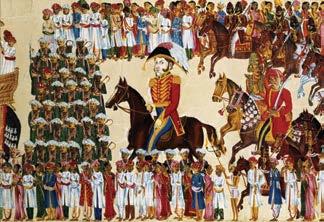
universalism and the postrevolutionary view of history as linear rather than cyclical converge, drawing India, China, Greece, Rome, and Western Europe into a single chronology presented through the biological metaphor of maturation. Like the sun, “world history goes from East to West: as Asia is the beginning of world history, so Europe is simply its end.” The “East” is “Asia,” the “Oriental World,” a place with spirituality but no rationality or subjectivity, harkening to Hegel’s view of India having a spiritual past but no “history.” “This is the childhood stage of history,” the earliest point of the chronology. Hegel then moves to Ancient Greece, Rome, and finally, Western Europe, history’s “adolescence,” “manhood,” and “old age,” respectively.
5 It is worth highlighting Hegel’s sources on Indian “literature” and “spirituality,” emerging from his encounter with translations of Sanskrit texts such as Śakuntalā or the Bhagavad Gītā, circulated by European philologers using “native” interlocutors. His interest was shared by his German contemporaries, such as the Romantic poet Johann Wolfgang von Goethe, who published an epigram on Śakuntalā in 1792, and philosopher Alexander von Humboldt, who delivered a series of lectures on the Gītā in 1827. Hegel went on to publish a review of Humboldt’s lectures that extended to a critique of Indian peoples, discussed by Simona Sawhney in The Modernity of Sanskrit (2009). Bernard Cohn’s Colonialism and Its Forms of Knowledge: The British in India (1996) discusses the unequal relationship between European philologers and their “native” interlocutors—i.e. Hindu brahmins and Muslim maulvis— to translate these theological, political, and literary texts from Sanskrit and Persian into European languages.
Each shift occurs through dialectic—the unity of opposites through sublation—involving immense material and intellectual conflict, hence Hegel’s reference to history as humanity’s “slaughter-bench.” Yet such conflict is essential to move from the “faith, trust, and obedience” of the Orient, to the emergence of “individualities” in Greece, to the “abstract universality” of Rome, to the sublation of the Christian religion to arrive at Spirit, “a higher form of rational thought,” in Western Europe. Two points bear consideration here. Firstly,
Hegel reiterates his naturehistory distinction and maps this onto a matter-idea distinction: Western Europe is the subject of history because of its “maturity,” for while “in nature, old age is weakness,” “the old age of the Spirit is its complex ripeness.” Secondly, of all the preceding stages of Hegel’s chronology—the Orient, Ancient Greece, and Ancient Rome—only the Orient remains, a relic in the modern world. The question becomes, then, how Western Europe is to interact with Oriental peoples, who are behind them in this chronology of progress.
This is brutally resolved by the logic of liberal imperialism, articulated by works such as Mill’s On Liberty. After stating his philosophical project of defending self-cultivation from the “tyranny” of society, Mill adds an important qualification:
This doctrine is meant to apply only to human beings in the maturity of their faculties. We are not speaking of children… For this same reason, we may leave out… those backward states of society in which the race itself may be considered in its nonage. Despotism is a legitimate mode of government in
dealing with barbarians… Liberty… has no application to any state of things anterior to the time when mankind have become capable of being improved by free and equal discussion. Until then, there is nothing for them but implicit obedience to an Akbar or a Charlemagne.
[emphasis added]
Note the parallels between Mill’s claim—which moves seamlessly from eighthcentury French monarch Charlemagne to sixteenthcentury Mughal Emperor Akbar—and Hegel’s chronology. India is as Europe was. It is at once the cradle of civilization
and the site of the colonial civilizing mission because it “has no history,” because it has not changed, stagnating under “Oriental despotism.” Thus, as Hegel described the Orient as the “childhood stage of history,” Mill likens the condition of barbarians to that of children, denying them liberty both in writing, through this treatise, and in practice, through his role in the British East India Company.6
It is through this cruel irony—an acclaimed Western theorist of liberty endorsing the despotism of colonial rule—that Gandhi’s class of nationalists came to develop a deep skepticism of Geschichte. Their access to Hegel and his German philosophical tradition was often mediated by English
and French sources, which were, in turn, mediated by the experience of colonization. As Gandhi highlights in Hind Swaraj, the idea that emulating Europe’s trajectory would allow Indians to progress enough to enjoy liberty had become suspect. “Progress” eluded Indians by design. Conceding that Indians were capable of progress would deny Britain its justification for colonial rule to the detriment of its material prospects— given the profits secured via “drain of wealth”— and its sense of national pride, defined against the backwards colonized subject. 7 As Macaulay’s famous 1835 Minute argued, even the most Westernized Indian, “English in tastes, in opinions, in morals and in intellect,” would remain “Indian in blood and color,” relegated to a position of hierarchical inferiority.

Thus, casting beyond nineteenth-century “moderate” Indian nationalists, Gandhi rejects the notion that proximity to Western-ness through an English education will secure Indian freedom. He then indicts the very nature of Western civilization and historical knowledge itself, finding it to be defective at its essence. “[The English] have the habit of writing history; they pretend to study the manners and customs of all people,” he writes early in Hind Swaraj, and “we in our ignorance then fall at their feet.” This charge is levied against intellectuals such as James Mill, father of John Stuart Mill and author of the 1818
History of India which had a central role in advancing the theory of inborn HinduMuslin enmity that Gandhi critiques in this section of Hind Swaraj. Yet when we return to the question Gandhi’s Reader poses later in the text—“is there any historical evidence [for] what you have called soulforce?”—it morphs into a sweeping historiographical critique:
You ask for historical evidence. It is, therefore, necessary to know what history means. The Gujarati equivalent means: “It so happened.” If that is the meaning of history, it is possible to get copious evidence. But, if it means the doings of kings and emperors, there can be no

evidence of soul-force or passive resistance in such history. You cannot expect a silver ore in a tin mine.
Gandhi’s “Gujarati equivalent” is itihāsa, a term derived directly from Sanskrit. Before turning to itihāsa‘s philosophical content, it is worth considering the term’s linguistic features—in contradistinction to Geschichte [history, story], which Hegel traces to its roots to demonstrate how it “combines… objective and… subjective”—if only because of Gandhi’s own attentiveness to the linguistic chasm between Indic and English terms. Itihāsa is formed through the joining of three words: iti [thus], ha [indeed], āsa [it was/existed]: “so (indeed) it happened.” It is linked to satyāgraha, the term Gandhi coined in Hind Swaraj to describe
what has been translated as “soul force” or “passive resistance,” arising from the joining of satya [Truth] and āgraha [grasping on to].8 Satya derives from sat [that which exists], formed of the same verbal root, as [to be/exist], used to obtain āsa. Both terms thus have ontological significance, identifying what exist(ed), Truth, as their object. Far from being speculative or counterfactual, “soul-force” is intimately linked to the past, to the past as itihāsa.
Gandhi makes it clear what itihāsa is not: a record of “the wars of the world,” the material conflict Hegel argued was necessary for dialectical progress.9 Works of itihāsa, including the Mahābhārata and Ramāyaṇa—the very epics Hegel saw as literary, not historical—acquired theological significance
8 While Gandhi used these terms interchangeably in Hind Swaraj, drawing on Western influences such as Thoreau’s writings and the American and British suffragette movements to conceptualize “passive resistance,” he would later distinguish between his satyāgraha as “soul-force” and Western “passive resistance”: the latter “does not necessarily involve complete adherence to truth under every circumstance.” See Gandhi’s “Letter to Someone in Madanpalli” (c. 1919).
9 While Gandhi does not cite Hegel explicitly, one is reminded of the fateful lines of the Philosophy of History—“India has no history” and history as the “slaughter- bench” of humanity—as Gandhi proceeds to cite a “saying among Englishmen that a nation which has no history, that is, no wars, is a happy nation.”
by denying their authors’ temporal contexts. In a process that Sheldon Pollock describes as “Vedicization,” authors erased traces of their subjectivity so that their texts might resemble the authorless Vedas, capturing Truth, universal, eternal, transcendent through the ages, to aid the individual soul on its journey to mokśa [liberation].10
There is no value ascribed to material conflict in an ontological framework that views materiality as māya [delusion] impeding the soul’s liberation via dissolution into God, Truth, that which exists—a belief underlying Gandhi’s rejection of all machinery, even his “body,” to “seek the absolute liberation of the soul.” As philosophies of history, both Geschichte and itihāsa trace progress, but they rely on different understandings of the site
of progress. Hegel draws on the post-revolutionary view of history as a linear path towards progress realized in the material world; Gandhi draws on Hindu beliefs that the soul progresses spiritually towards mokśa while the material world moves cyclically through yugas, four million year cycles, for eternity.11 Geschichte thus records material conflict to mark humanity’s stadial progress, precisely what itihāsa transcends to guide the soul’s spiritual progress.
Introducing itihāsa thus allows Gandhi to recast Hegel’s belief in India’s changelessness as an indication not of “backwardness” but of “strength.” Europe “learn[s]… from… Greece or Rome, which no longer exist in their former glory,” while “India remains immovable,” declares Gandhi. He has
10 See Pollock’s discussion of the “denial” of history (in the Western disciplinary sense) in his “Mīmāṃsā and the Problem of History in Traditional India” (1989).
11 Perhaps this might be closer to the premodern European view of history as cyclical. Gandhi makes allusions to the yugas—over four million year long cycles, during which the world ascends and then descends through the same four stages, in Hindu theology—at a few points of Hind Swaraj, including his reference to British colonialism as India’s “Black Age” [kalyuga, the lowest point in the cycle], to satyāgraha as drawing from a “higher” stage, for which “India is not [yet] ready.”
seized upon precisely the anomy we identified earlier: of all the preceding stages of Hegel’s chronology, only the so-called Orient still exists. “It is a charge abasing India that her people are so uncivilized, ignorant, and stolid that it is not possible to induce them to adopt any changes,” a view we might trace to imperialists such as James Mill. This is a misreading of India’s ‘changelessness,’ a “charge… against our merit.” “What we have tested and found true on the anvil of experience, we dare not change,” Gandhi writes, invoking itihāsa‘s emphasis on preserving Truth in a continuous line joining past and present, with no definite beginning or end, rather than on documenting the temporal ruptures and shifts.
What emerges is an antimaterial view of history and civilization, where the site of violent conflict—and of progress—shifts from the material world to the individual soul. By the end of Hind Swaraj, Gandhi’s

satyāgrahi12 is urged to relinquish attachment not only to Western “railways,” “lawyers,” and “doctors,” but also to their own body. Gandhi advances this radical argument by drawing on the antimaterialism of the Mahābhārata, a seminal work of itihāsa. Satyāgraha “is a method of securing rights by personal suffering,” requiring the “courage” to “approach a cannon and be blown to pieces” and “kee[p] death as a bosom-friend.”
This language evokes the Bhagavad Gītā [Song of God], a portion of the Mahābhārata in which God, through the deity Krishna, persuades
12 Practitioner of satyāgraha.
the archer Arjuna to return to battle after he retreats in fear of slaying his relatives on the opposing side of a great war. Krishna reminds Arjuna of the cyclical nature of material existence—
“jātasya hi dhruvo mṛityur dhruvaṁ janma mṛitasya ca” [for one who is born, death is certain, and for the dead, (re)birth is certain]—urging him to sacrifice attachments, perform his duty at battle, and liberate his soul.13
It is striking that Gandhi
invokes the Mahābhārata, an account of cosmic war, in a work that argues against the very anticolonial “extremists” who cited this text to justify violence against the British.14 As Simona Sawhney argues, Gandhi’s reading of the Gītā reveals how itihāsa can strip conflict of its material quality, recasting it as an internal battle overcome by self-sacrifice. Hence, Gandhi analogizes Arjuna’s struggle to the satyāgrahi’s, claiming the “true Kurukśetra [the battlefield on which Mahabhārata‘s war was fought] is our body.”

In turn, Gandhi does not see a lack of material conflict as a sign of stagnation. Periods of “nature” carrying on sans “interruption” are moments of spiritual progress when soul-force prevails in individuals. This inverts Hegel’s naturehistory distinction to associate the former, not the latter, with the realization
13 The mention of “birth” for the dead references reincarnation. As Simona Sawhney observes in The Modernity of Sanskrit, in the Gītā and subsequently in Hind Swaraj, “to be selfless is perhaps to be concerned solely about the transcendent and otherworldly self,” existing independent of the physical body and the material world.
14 Cf. “extremist” Hindu nationalists such as Sri Aurobindo and Bal Gangadhar Tilak.
of higher consciousness. The Indian villages Hegel and Marx identified with stagnation under “Oriental despotism”—unable to progress dialectically until British rule engendered material change—Gandhi views as remnants of a higher age, ancestors “satisfied with small villages” for they saw “happiness [as] a mental condition.”15 His ideal of swarāj is neither Hegel’s nation-state nor primitivism. Rather, it centers on individual “self-rule,” realized by and within the self, not through the state law-making or revolutionary violence—both of which, to him, remain bound up in materiality.
We are thus left with two philosophies of history, Geschichte and itihāsa, which
seem to be negatives of one another, in a dialectic of material and spiritual, temporal and eternal.16 While Hegel maintains an idealist stance—which later thinkers such as Marx would invert—his Geist [spirit] must be realized in the material world, and thus, functions differently from the notion of spirit realized by transcending materiality in Gandhi’s framing. The question remains, if we might extend this dialectical analogy one step further, whether or not there is any sublation.
Some reckoning of these two philosophies of history seems urgently necessary. We saw Mill deploy stadial progress to marginalize Indians’ liberty, revealing the dark side of Geschichte, and Gandhi subsequently use itihāsa to recast these derisive perceptions of India, reconceptualizing swarāj in
novel and radical terms.17 Yet itihāsa raises other concerns. On his part, Gandhi condemned child-marriage, bans on widow remarriage, and the ill-treatment of Dalits as social “defects” that must be eradicated: to him, these had no place in India’s “ancient civilization,” so they can have no place in twentieth-century India. Yet the problem remains that the supposed changelessness of Indian society and sacrality of its Sanskrit canon was deployed by a conservative Hindu orthodoxy, in complicity with colonial authorities, to entrench these practices at the expense of women, Dalits, and other marginalized Indians. In other words, as Pollock argues, conservative power could use itihāsa to “naturalize” existing “asymmetrical relations of power,” claiming these
have existed since time immemorial.
Where does this leave Indians who were socially marginalized by orthodox Hinduism—specifically Dalits and women? Their case is especially fraught when we consider how their marginalization was invoked by proponents of the Western-European ‘progress’ narrative. Hegel, conceding that a Hindu legal code exists, finds that “social differentiation was immediately ossified into caste distinctions” in India, preventing the coalescence of civil society and the nation-state. Mill and other liberal imperialists argued that gender relations were a measure of civilizational progress, seizing upon satī, 18 child marriage, and other orthodox Hindu practices to argue for India’s inability
17 At the time of Gandhi’s writing this text, nationalists’ political demand for swarāj was at best dominion status within the British Empire, which would have preserved Britain’s political structures; it was only in 1930 that the Indian National Congress began to seek pūrṇa swarāj [complete self-rule], i.e. full political autonomy from the British, a position that likely still does not go as far in disavowing the structure of the European nation-state as Hind Swaraj does in 1909.
18 Lit.: “she who exists,” an idiomatic reference to a “good woman” or “good wife”; this term would be used by the orthodoxy to describe widows who died by self-immolation in their husbands’ funeral pyres, and subsequently by the British to describe this act of widow self-immolation for the purpose of outlawing it in 1829. See Lata Mani’s Contentious Traditions: The Debate on Sati in Colonial India (1998).

to enter into “modern civilization” on its own. If any resolution is to be found between Geschichte and itihāsa, it can perhaps only be found in the figure of the socially-marginalized Indian subject, denied direct recourse to both philosophies in their original forms to escape being subjugated as Indians on the one hand, and as Dalits or women on the other. We finally turn to the approaches of two such authors, Ambedkar and Mahadevi.
Ambedkar’s Annihilation of Caste
Ambedkar, a Dalit scholaractivist who studied at the London School of Economics and Columbia University
before returning to India in the 1920s, launches a searing critique of Hindu theology in his Annihilation of Caste that resists any glorification of Indian ‘changelessness.’ He takes issue with nationalists’ argument that Hinduism is redeemed by the fact that “Hindus have survived.” To Ambedkar, eternal existence is no source of pride. “It seems… that the question is not whether a community lives or dies,” but “on what plane does it live,” he writes, concluding that “a Hindu’s life has been a life of continuing defeat.”
He thus rejects not only Gandhi’s praise of India’s changelessness in the tradition of itihāsa, but also the European Orientalist construction, reflected somewhat in Hegel, of an Indian ‘Golden Age’ that produced a venerable Sanskrit canon. To Ambedkar, there is no glorious past from which India fell into decline and stagnation (per the Orientalists) or which present-day Indians can revive (per the nationalists). He instead sees “a life which
is perishing everlastingly,” a canon of Sanskrit works mired in the material reality of an oppressive caste “system” that had no place for Dalits or, as he later alludes to, for women.19 The only recourse is a break from the past, specifically the religious past, so that it can no longer authorize castebased power relations.
We see Ambedkar move to recast stadial progress to advance a compelling argument that “social reform” to abolish caste must take precedence over any “political” or “economic” agenda. As he notes, this puts him at odds with both committed nationalists, who primarily sought political independence, and Socialists, who primarily sought economic restructuring. Turning to nationalists’ views first, Ambedkar claims “political revolutions have always been preceded by social and religious revolutions,” citing the
Protestant Reformation as a “precursor of the political emancipation of the European people,” Muhammad’s intervention as a religious revolution paving the way for “Muslim Empire,” and “the religious and social revolution of Buddha” preceding the “political revolution led by Chandragupta.” Per Ambedkar, political change cannot be realized without social reform, which in India must take the form of the abolition of caste within Hinduism. Note Ambedkar’s historical references—spanning Western Europe and Central and South Asia—which break from Hegel’s Geschichte in acknowledging the prospect of revolution in the supposedly stagnating ‘Orient.’
Ambedkar proceeds to extend this argument against socialists, asserting historical difference to once again reformulate the philosophy
19 It remains unclear as to what gender relations will become in the aftermath of abolishing caste—Ambedkar divides “social reform” into two categories, “reform of the Hindu family” (child-marriage, satī, widow remarriage) and “restructuring of society” (the abolition of caste) early in the work to argue for reformers’ neglect of the latter. His later invocation of women might indicate that he views these two reform struggles as intertwined; see ibid at 219, 270.
of stadial progress. “The fallacy of the socialists lies in supposing that because in the present stage of European society property as a source of power is predominant, the same is true of India, or the same was true of Europe in the past,” he argues. While Ambedkar compares Europe and India, his invocation of historical difference breaks from Hegel’s Eurocentric chronology that placed India at “childhood” and Europe at “old-age.” Nor does Ambedkar suggest India blindly imitate Europe to realize freedom—indeed, quite the contrary. “If the source of power and dominion is, at any given
time or in any given society, social and religious, then social and religious reform must be accepted as the necessary source of reform,” he concludes, a resounding statement of his argument regarding the social reform agenda that must be adopted in British India. Certainly this is closer to Geschichte than to itihāsa, for it heeds the temporal context of a particular society; however, here stadial progress does not inevitably culminate in Europe and leave India in stasis.
We might situate Ambedkar’s intervention in a longer tradition of recasting Hegelian dialectical progress: spanning Marx, who argued the nationstate must be sublated to arrive at Communism, and Nietzsche, whose dialectic, far more violent than Hegel’s “slaughterbench,” resists the inclination to ascribe meaning to violence and suggests that we might never arrive at a final sublation. Where Ambedkar breaks from these nineteenth-century European philosophers is in his

commitment to nonviolence, including his use of the language of reform rather than violent revolution, which is closely tied to his refusal to entirely relinquish religion.20 He seeks to desacralize the Āryan past that had been glorified by Orientalists and conservative nationalists alike in ‘Hindu law’ texts such as the Manusmṛti, declaring the “remedy is to destroy the belief in the sanctity” of this canon. Yet he leaves openended the result of this stadial reform—he cannot determine what religious doctrine will take the place of existing Hinduism. To his Hindu audience, he declares,
You must give a new doctrinal basis to your religion—a basis that will be in consonance with liberty, equality and fraternity; in short, with democracy. I am no authority on the subject. But I am told that… it may not be necessary for you to borrow from foreign sources, and that you could draw for such principles on
the Upanishads. Whether you could do so without a complete remoulding, a considerable scraping and chipping off from the ore they contain, is more than I can say.
Months before Ambedkar died in 1956, he converted to Buddhism, disheartened by the Hindu and Muslim religious orthodoxy’s refusal to pass a Uniform Civil Code that would have regulated social reform across all religious communities in independent India. Yet in the above lines, we see a younger Ambedkar positing stadial progress whose culmination, unlike in Hegel’s Introduction to the Philosophy of History, remains indeterminate. He suggests there might be emancipatory potential in certain Sanskrit texts, but they must be reread critically, with recognition of historical difference—without blind veneration afforded to colonial and brahmanical constructions of India’s
20 Ambedkar’s defense of religion in the form of Buddhism defies the rejection of religion in both Marx, as the earliest form of man’s “self-alienation,” and in Nietzsche, as a manifestation of the “ascetic principle.” He also dismissed Communism on the grounds that he agreed with Socialism’s ‘ends’ but not the ‘means’ of violence; see Gail Omvedt, Dalits and the Democratic Revolution: Dr. Ambedkar and the Dalit Movement in Colonial India (1994).

religious past.
VI. A Feminist Recasting of Itihāsa: Mahadevi’s Chānd Editorials
Here, on the subject of conversion, we might turn to Mahadevi’s intervention as an alternative approach to reckoning with stadial progress and itihāsa. As a young woman, Mahadevi had considered converting to Buddhism and becoming a bhikkhuni [Buddhist nun] to escape her Hindu child marriage. However, she eventually rejected
the view that conversion would be emancipatory. Troubled by patriarchal structures she encountered in Buddhist monasteries, she grew acutely aware of the dominion religious orthodoxy claimed over Indian women, extending even beyond the Hindu context. Unlike Gandhi and Ambedkar, Mahadevi was not sent abroad to study—women, even from higher-class families, rarely were—and received her B.A. and M.A. in Sanskrit in Allahabad. There, after encountering Gandhi’s
Hind Swaraj in the 1920s, she became committed to satyāgraha, vowing to communicate exclusively in Hindi for the remainder of her life. Mahadevi thus is left with a more limited exposure to Western reference points such as Hegel, Mill, or Marx, but contributed significantly to Indian anticolonial and reformist circles through her Hindi essays and poetry. Her linguistic background, moreover, renders her well-situated to re-read India’s scriptural past—as Ambedkar briefly alludes to at the end of Annihilation of Caste—to seek liberation for
Indian women.
Thus, as we have seen Ambedkar recast stadial progress to find emancipatory potential for Indian Dalits, we see Mahadevi recast itihāsa to find emancipatory potential for Indian women. In a series of 1930s editorials she published for the women’s journal Chāṅd, Mahadevi moves seamlessly between her present and an indeterminate past, reflecting the atemporality of the itihāsa tradition, while introducing a critical awareness of the material subjugation of
women that accompanied their attempts at spiritual “progress.” “Objects that are more beautiful or delicate than ordinary, earthly objects are… either elevated to the rank of the celestial” or “become the objects of neglect and disdain,” she writes, and “the irony of fate has made Indian woman experience both these states fully.” She offers no temporal reference points, which seems more reminiscent of Gandhi’s treatment of the past than Ambedkar’s. Where Mahadevi casts beyond itihāsa is in arguing for a duality of material and spiritual conceptions of the past, rather than denying the former entirely. The Indian woman was at once “goddess in the sacred temple” and “prisoner in… her home,” her spiritual advancement imperiled by the threat of material subjugation. The spiritual cannot be considered without reference to the material.
This approach generates
a powerful re-reading of India’s past, wherein Mahadevi finds a lineage of female resistance that extends from the female characters in works of itihāsa to present-day women anticolonialists, poets, and saints. Taking the character of Sītā in the Ramāyaṇa, invoked by Hindu nationalists to construct tropes of female selfsacrifice, Mahadevi instead finds a woman whose “life embodies courage,” following her path of duty despite being unjustly banished by her husband. Juxtaposing Sītā’s material deprivation with her mental fortitude, Mahadevi identifies “courage” where her orthodox contemporaries had valorized female “meekness.” Such was the legacy of “so many women,” from Mughal-era female saints such as Meera and warriors such as Padmini, to British-era revolutionary women such as Rani Lakshmibai, and women writers whose literary works have “given voice to… the

Indian woman.”21 Mahadevi turns to the past and finds a tradition of female resistance that transcends temporality, emerging from women’s striving for spiritual progress amidst material subjugation. The corollary to this argument is that women and other marginalized Indians have been lied to about their past: they have been told that their subjugation is the result of eternal religious law, when in fact it emerged from contingent material conditions. “Under the pretext of preserving an artificial past,” writes Mahadevi, “the devis [goddesses, women] have tolerated numerous injustices, not because they do not have the power to resist, but because they thought they would be deviating from their duty if they questioned the rightfulness of acts of men’s society that were supposedly based on law.” Here we encounter the nuance of Mahadevi’s use of itihāsa,
her refusal to “blindly” romanticize ancient India.
Female self-sacrifice, lauded by nationalists such as Gandhi as a model for the satyāgrahi, is “worthless, like the submission of helpless… animal,” if the woman has not “investigat[ed] the rightfulness of [the] principle” on which they are based—that is, if they are forced by her material subjugation, denying her spiritual selfhood and interiority.
Thus, like Ambedkar, Mahadevi also repudiates ancient codes of law such as the Manusmṛti that enshrined the inferior status of women and Dalits. Yet while Ambedkar invokes the language of stadial progress to break from India’s spiritual past, Mahadevi argues against these law codes by historicizing them: she ties them to materiality and thereby devalues them within the ontological framework of itihāsa. The laws that “contracted all

21 Meera was a sixteenth-century Hindu saint whose devotional Bhakti poetry was an early inspiration for Mahadevi; Padmini, a thirteenth-century Indian queen; Lakshmibai, a nineteenth-century Indian queen who played a central role in leading the Revolt of 1857 (which Mahadevi here refers to as India’s “first war of independence,” and colonial histories dismissively refer to as a “sepoy mutiny”).
of women’s rights” and “erect[ed] walls of caste” were the result of material “warfare,” she argues, which “affected the position of woman in society to such an extent that [she] began to be thought of as man’s individual property.” For evidence, she does not turn to the historical archive— as Ambedkar does in his references to religious reform movements—but instead returns to the treatment of women in works of itihāsa. “The society of the Mahabharata and the Ramayana,” enmeshed
in warfare, “is a blazing testament to this fact,” its ill-treatment of female characters manifest in “the fire ordeal, or the exile of a virtuous wife, or the staking of a wife in the game of dice like any other item of wealth.”22 Breaking with Gandhi’s antimaterialist readings of these epics, Mahadevi makes explicit the material reality of war and its implications for the legal subjugation of women, even while she lauds the spiritual resistance of female characters such as Sītā. Re-casting the itihāsa
framework, she thus argues that “it is now necessary to change the various ancient legal provisions that affect women negatively” to secure conditions that will allow women’s spiritual progress towards eternal Truth.
Thus, the language of “progress” and “reform” takes on a new cast in Mahadevi’s editorials wherein its realization is no longer predicated on a full disavowal of the past. As she would describe in a later essay,
Since this stream of progress is restricted from one side by time and place and from the other by eternal life values, it creates a union of the old and the new in each age. We understand our culture’s original source and aim by looking at our own times in the same way that we apprehend a river’s unseen
origin and final destination from a limited perspective from the shore.
Her naturalistic metaphor— reminiscent of Gandhi’s association of “nature” with “soul-force” in Hind Swaraj—maps a terrain of the past which has no definite beginning or end, no clear sense of temporality, and is certainly closer to itihāsa than Geschichte. Simultaneously, its insistence on “progress” resists the orthodoxy’s attempts to fix the figure of the Indian woman in the “past,” suggesting that itihāsa‘s emphasis on the spiritual over the material might be redeployed to imagine a liberating future for the most sociallymarginalized elements of Hindu society.

This investigation has sought to trace the critical project taken on by three Indian authors, Gandhi, Ambedkar, and Mahadevi, to define a new mode of relating to the past: a philosophy of history that would emancipate their
communities. Their task is all the more critical because the dominant philosophy of history in their times— Geschichte, as articulated by Hegel and deployed by Mill—constructed a version of India’s past that actively justified its colonization. Published at the turn of the century, Gandhi’s Hind Swaraj, introducing the philosophy of itihāsa and rejecting the material for the spiritual, offered a means of redeeming the “changelessness” that Hegel, Mill, and other Europeans levied as a charge against Indian peoples.
In the aftermath of Gandhi’s text, the subsequent interventions of Ambedkar and Mahadevi in the 1930s reveal divergent possibilities for how this negation of
Geschichte with itihāsa might be ‘sublated’ by looking to the margins of colonial society. Ambedkar cites historical difference to re-cast stadial progress; Mahadevi undertakes a possibly redemptive re-reading of India’s theological past. While these arguments might not converge upon a singular philosophy of history, they reveal the significance of critically examining the past for individuals actively involved in re-formulating the contours of their present. Before Gandhi could argue for Indian independence, and before Ambedkar and Mahadevi could argue for the simultaneous pursuit of “social reform,” they had to make freedom imaginable. To this end, they had to search for emancipatory potential at the very limits of history.23
23 Author’s Note: This is a revised version of a paper I wrote in April 2022 for my Contemporary Civilizations course. It was shaped by an unlikely confluence of experiences and mentors during my first two years at Columbia that I remain profoundly grateful for: Professor Sudipta Kaviraj’s Spring 2021 Gandhi and His Interlocutors lecture and continued guidance in office hours in Spring 2022; summer research on Mahadevi Varma’s feminist essays; Professor Manan Ahmed’s Spring 2022 South Asia: Historiography in Question seminar; Professor Shiv Subramaniam’s 2021-22 Elementary Sanskrit office hours (which frequently shifted from Sanskrit grammar questions to discussing German idealism); and Professor Charly Coleman’s Fall 2021 Enlightenment seminar and 2021-22 Contemporary Civilizations section.
Content warning: Some body horror
Iam never at peace. My unfinished tasks, unanswered emails, unfulfilled plans poke into my ribs like the underwire of a bra, an anxiety everpresent beneath my blouse. I could knit a blanket out of my loose ends.
Lately I feel gravity more intensely; if I walk past a patch of grass on the way home from work, one especially lush or especially vast, I fight the urge to lay down. Sometimes I lose, and end up staring at a network of leaves and branches, cells and capillaries, sinewy veins between leafy flesh, channels of light flowing through. I play at cloud shapes to distract myself, name them after anything corporeal. A cumulonimbus clown. A cirrus dove. A lock of stratus hair. Still these things come from flesh. It is not hair, I tell myself. It is a river, a streak of paint, an exhalation of smoke. I lie very still on the cold dirt and close my eyes and pretend I am a corpse. It’s the closest I get to peace.
So none of it is my fault, really. No matter what I did, I couldn’t sleep. It started with shorter periods. One all nighter was enough to drain me out, until it wasn’t. Then I went 36 hours without sleeping, and eventually two days. Then I stopped keeping track. My body forgot what it was supposed to be doing. I no longer felt like a human, so I don’t understand why anybody would be expecting me to act like one.
I go out on a Wednesday— it’s the first time I leave my house in days—and the first time I see friends (who think I am just busy with work) in weeks. I meet a Ukrainian lesbian on the back patio of a bar. She has tattoos and a bad haircut. She tells me how her friends at home have been captured and electrocuted by Putin’s forces. I tell her I am sorry about that. I offer her a drag of a cigarette, a limp-wristed apology. She declines. She doesn’t smoke. I learned a few lines of dialogue ago that she doesn’t drink, either. I have only ever been
electrocuted by mistakenly sticking my finger in a socket, so I can afford to waste youth on things like cigarettes and alcohol and all-nighters and going out on a Wednesday. I entertain myself with the thought that she does coke, molly, and ketamine exclusively, swears off gluten and dairy, and only sleeps in two to four hour increments, some commandment of the European techno-house lifestyle. But she is still here instead of Berghain. I am sobering up by the time our conversation trails off, but her face is still a black spot in my memory.
I find that in my new, sleepless lifestyle, I can’t recognize faces like I used to. I pass anyone in the street and see a face from my childhood, or someone I’m sure I know but can’t place, or someone stares at me or smiles and waves like we know each other, but they’re a collection of eyes and ears and skin that I’ve never seen before in my life. I know even now, looking at this woman’s face so intently, that I will forget it
immediately.
On Thursday, I miss work and all of the phone calls that follow my unexplained absence. If they can never contact me to reprimand or fire me, then I can never really be fired. That is the logic of someone whose brain is stuffed with cotton.
In between bouts of lying awake with my eyes closed, I spend the day scrolling through Instagram. In all these hours, I pull what is likely miles of content through my screen with my thumb. All of these glossy, symmetrical faces with their
medical-grade proportions. Pillow lips. Soft eyebrows you could knit a blanket with. Ski-slope noses and gentle hollows where their necks meet their collarbones, hard and soft at the same time, a perfect juxtaposition of chiseled jaw and slanted cheeks. The eyes of an innocent baby deer who somehow also wants to get fucked. She is androgynous but also distinctly feminine. She has the skin and the corrupting gaze of someone underage, but the elegance and assets of someone much older. I don’t know if I can never tell these women apart because I can’t tell anyone apart anymore, or because they really all just look the same.
I realize I can’t describe their cheeks as “supple,” though, not like I used to. There is something missing under the bones, as if years of posing with that flesh sucked in actually shot it down their esophagus until they burned it up in their stomach acid and shat it out of their pristine waxed-or-bleached assholes.
I eventually see a post about the trend of surgical buccal fat removal. So that’s where it’s all gone. I had always loved their cheeks. That soft, tender flesh, made for pinches from grandmas or kisses from lovers or as a reference point for the natural waning of age, sliced off and tossed into a metal bin and disposed of as biohazardous waste. I understand why they did it, even if I don’t agree with it. Their faces look more chiseled, and any threat of a faint pad of fat under their chins is gone. While still laying in bed, I push up on the underside of my own chin, prodding at the excess flesh I had never seemed to notice before. I stick my fingernail into the side of my face, right next to my ear, drag it into my cheekbone. I imagine all the flesh being stripped off. I already feel lonelier without these extra cushions, these margins of my face. I guess when you’re a centerfold, you don’t need them. If they don’t want this fat, I think, then I will take it.
They say New York is the city that never sleeps, but

whoever they are is a liar. The restaurants close and the people on the streets thin out, and even the pigeons go curl up somewhere in a tree for hours. I have this on good authority because I, unlike New York, really do never sleep, so I get to watch it doze off and wake up again. If that sounds romantic or poetic or beautiful, it’s not. It’s just lonely.
I have a shopping list, but it’s past 8 now and the hardware store is closed, so I have to wait to complete it. I toss and turn throughout the night. Sometimes I’m so sleep-deprived I get delirious and can’t even tell if I’m asleep or awake anymore. My thoughts get so vivid I think my subconscious may just have taken over. Most people experience sleep like stepping off a cliff into the water below, but my cliff has been so eroded by the blue-light of screens and medication interactions and my body’s inability to recognize the intended function of my bed, that for me it is more like a wading in. I had only met the Ukrainian lesbian a day and
a half ago, but it feels like a different season. I wonder if she knows how to swim past wading. I can’t remember if Ukraine is landlocked.
I think time must pass differently in the poorly-lit pit of my bedroom in this apartment. I only leave to pee or sometimes eat, and I only do it when I know my roommates won’t be around, scuttling from the fridge to the toilet (but never the shower).
It’s February, so the sun rises around seven. It’s Friday, so the store opens at eight. I alternate between sudoku and Tetris and 2048 on my phone until 7:55, when the sky through my window is the color of raw chicken breast. I grab my coat and hurry out of the apartment before either of my roommates wake up. The streets are blanched with sun and salt, and the cold air is probably supposed to feel good on my face, but it feels like I’m being cryofrozen into a grimace. I pass by the other early-morning risers, and wonder if they think I’m like them. If I tried, I could
go to work at nine. But not now, not today, because I have a mission.
It begins with entering the hardware store as soon as it opens, after loitering outside for about thirty seconds before they flip the sign. As such a punctual first customer, I am rewarded with the privilege of wandering through the tall, narrow aisles undisturbed. In the suburbs, aisles are wide and of reasonable height, but everything in New York is squished together and stretched upwards, and for a second the thought makes me so claustrophobic I want
to throw up. I wonder if I lived in a place with aisles wide enough for two people to pass by without brushing each other that I would be able to sleep. Inhaling so fewer chemicals and carcinogens, and turning off that constant background track of horns and sirens and screeching brakes and stray shrieks. Even if I tried to leave the city, though, I can’t see past the tall buildings or through the longer avenues, so I don’t think I’d actually be able to find my way out.
I finish my trip with proof of each item I’d written in my notes app:
• two coolers, red with white lids and black wheels
• a funnel, plastic with little risen ticks on the side to indicate volume
• two knives, one long and serrated for bread, the other small and sleek for fruit
• a 24-pack of Poland Springs bottled water
• a pool float, green and slightly translucent with smelly plastic, which a gruff man in a stained

t-shirt had to retrieve from the basement for me, because again, it’s February • and finally, a fairly nice blender, which I can afford because when you never leave the house, you actually find yourself spending a lot less money. I stuff all the things in either of the coolers and wheel them home fairly easily, and make it back to my room without a roommate sighting—or I guess without them having a me-sighting, because I am certainly the rarer breed. I can pretend I live alone in this state, or
maybe just with ghosts that share my bathroom and my electricity bill. If anyone is the ghost though, It’s probably me.
I wait until nightfall, scrolling on my phone, watching all the backstage stories of Fashion Week, catching glimpses of shadows on the sides of the models’ faces. A couple hours past sunset I put on black slacks and a white button up, the first time I’ve changed in days. I tie my hair back into a neat bun. I almost feel like a person.
I’ll spare you the boring details, because it’s not that fun to explain. I never actually expected it to work, you know, so if anything it’s sort of their fault for not having better security. You can find the show schedules online if you just click the right links. When I got there I just slipped in with some of the catering staff, and tried to convince myself I was really supposed to be there, so that it might reflect in my expression. The coolers made it more believable, actually.
The main room backstage had black floors and aisles of lit mirrors, framed by thick floor-to-ceiling curtains. I follow the caterers to a small room off of a less glamorous cinder block hallway, where they assemble white folding tables with trays of meat, cheese, fruit, and pastries. I read online that models are not allowed to eat or drink water for something like a whole day before, to dry and thin them out like strips of beef jerky. This, then, is their reward for walking a few hundred feet without passing out. I open the correct cooler, thankfully, and off in the corner on another table I neatly line up the bottles of water.
“I didn’t know we were bringing water,” one of the actual caterers said. Her face is familiar and foreign at the same time, like we have briefly locked eyes in line for a club bathroom once, but neither of us can remember.
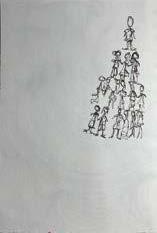
“Oh yeah,” I reply. “I just work for the studios. They told me to put these waters in here before the show’s done.”
“Probably smart,” she says, and goes back to rolling up strips of Prosciutto into neat tubes. That was the most anyone would question me the whole time, and it was also the most I had said to anyone in two days. I was surprised my voice still worked.
I finish setting up the waters, trying to placate my shaky hands. I’m betting on the fact that the girls will be too delirious with hunger and thirst to notice that the bottles’ seals are broken.
When my task is done, I find the closest bathroom and sit in the wheelchair stall with my feet perched on the lid and play sudoku for 45 minutes. Then I return to the room. It’s a scene I couldn’t have imagined better myself. A group of them are collapsed on couches against the walls, splayed atop layers of clothes and coats. The wonderful and artfully presented product of both hunting and gathering on the tables was merely picked at. Too bad I have no time and even less of an appetite.
I find where I’d shoved the other cooler under the table, and retrieve both the long knife and shorter one, just in case, because I don’t know which one will work better. I roll the now empty cooler across the floor, and it makes a bit of a rattling sound, but none of the girls even flinch. I hope none of them are dead. The pills had never worked for me, so I thought if they were going to work for these women, who were probably hopped up on diet pills and stimulants, that I’d better be giving them a healthy dose. As one last measure, I shut the door and switch the lock into place.
Before, I spared you the boring details, so now I will spare you the gory ones.
I walked back down the long cinderblock hallway and out the side door without looking back. Upon completing my duty I wiped off any concerning substances from the outside of the cooler with some of the dresses on the couch. Tulle and nylon netting aren’t very absorbent, but it worked fine enough. When I
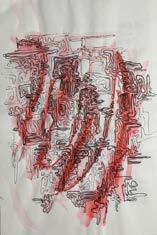
finally emerged onto the cold street, cobblestone and lined with sleek black cars, I could even see lights glittering on the Hudson in the distance. I think to myself that it’s funny the studios are in the Meatpacking district, ironic maybe. I take a deep breath, smelling the air. Now it really did feel refreshing. I was home free, and felt my heart beating, like a real human. It was adrenaline, a rush, anxiety—arguably one of the most mortal emotions.
Another reason I could never leave New York is that people don’t look twice when you are towing two giant coolers down the street or on the subway. Some guy even helped me carry them down the steps into the station. I had latched them securely, thankfully, so neither opened. Even if they spilled, the subway has seen weirder sights, and even weirder bodily substances. Much like the hardware store man had not asked about my needs for a pool float in February, this man did not inquire about the contents of my coolers. And they say New Yorkers are rude. Like I
said, they are a liar.
I check my roommates’ locations in the intermittent service I get on the ride home. They are both at different downtown bars, and will be out for at least the next hour. I get home without a hitch, though I am now sweating from all of the dragging. I did not think of how heavy the coolers would be, or at least how atrophied my muscles have become.
In my room I peel off my clothes and put on a fresh combination of t-shirt and sweatpants, in dark colors, to be safe. I plug in the blender, which I have already unpackaged. I unroll the float. And since there is nothing else to do, I immediately begin grabbing gobs of flesh from the coolers, placing them in the blenders, putting it on the “liquify” setting, and then dumping the blender’s contents into the float via the funnel. I do this about twenty times, my fingers
sore and my forearms burning, when I realize I am actually beginning to
feel tired. I think I may have found exactly what I needed to shake up my circadian rhythm. This little excursion has been good for me.
Once both coolers have been scraped clean, the float is a bit squishier than I’d like, but certainly full. I rip off my sheets and comforter, and take the clean, fresh pair from the bottom drawer of my dresser. The float fits quite well on my twin bed, if not a bit too narrow. I ease over the fitted sheet, then spread the loose one on top of it, creasing the corners in the manner of a video I saw online. The ritual is soothing,
and I think I can even feel a yawn swelling in the base of my throat. I add the comforter, plain and white like my walls, and finally a singular pillow at the head.
I slip in, careful not to disturb all of my expert folding and smoothing and tucking. I lay my head on my pillow and put my hands at my sides over the comforter. I close my eyes. I feel my body sink into the ocean of fat beneath me, then into the mattress, through the floors below and the dank warmth of the basement, into the soil with the pipes and worms and chemical runoff, until I am falling into nothingness. I
pretend I am like the models: paralyzed and hollow, cheekless. I did them a favor; I removed it for free. Giving me a new mattress topper is really the least they could do.
The matter I sink into is human. It’s flesh, it’s body, just like me, just like what’s inside me, my face, my thighs, my lower stomach, purely human, untouched by scalpels or the blessed curse of otherworldly beauty. My humanity is still in my face. It cannot be taken from me by days of living as a corpse, but I can choose to cut it out.
The skin of my back and my mattress topper are fused together somehow, through
the lifeless fabric of cotton sheets or a polyester-blend t-shirt. I am human.
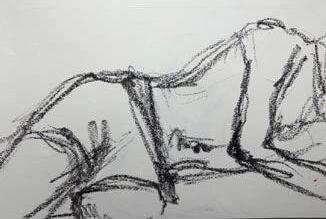
I don’t need to look at clouds to visualize the body. I don’t try to fight it, either. I etch cheekbones into the backs of my eyelids, sovereign and stolid as the frame of the face, gaunt and glorious. Cliffs you could fall off into seas of discarded tissue, 115-degree angles gifted by God and perfected by me.
I tumble back into the flesh and the bone and the fat and the blood, it all looks the same when you get beneath the faces, you know, and now all of the faces look the same too. I am no longer wading, I am falling, floating, I can feel myself suspended in the liquid, a corpse adrift. Until there is really nothing—if I am not dead, then at the very least I am asleep.
Bernard Harcourt is the Isidor and Seville Sulzbacher Professor of Law at Columbia Law School, and is the director of the Initiative for a Just Society at the Columbia Center for Contemporary Critical Thought. In addition, Professor Harcourt is a prominent author on modern critical theory and political theory. His recent writing has focused on mobilizing praxis in the modern world, looking to collectivist movements to motivate action. Professor Harcourt also facilitates the 13/13 Seminars, an annual set of talks focusing on an issue in contemporary critical theory. This year’s talks are centered around utopianism, attempting to carve out utopian visions in response to modern crises.
Gadfly: The philosophical work that you, as well as the panelists of the 13/13 series, engage in to formulate new conceptions of utopia is one in which the status quo is in constant contention. I was hoping we could begin by defining your concept of the radical theory of illusions and how it can help us towards that end.
Bernard Harcourt: Before delving into the concept of illusions, I think it’s important to understand that it needs to be framed within the context of both
values and of action. It is a foundational piece of a critical theory of action, because it unveils ways of understanding the world. I tend to think that we are able to place ourselves in a different position in relation to the world and to our own actions. So in a way the theory of illusions is a condition of possibility, even of action. And your question is interesting because, in part, you’re raising the problem of how a positive vision of a concrete utopia can escape the problem of illusions. In other words, if one has a radical theory of
illusions, wouldn’t it apply as well to utopic visions? And I think it does. In the sense that part of the theory of illusions is a recognition that we always need to engage in a critique that is likely to undermine our own reconstructed visions of the future. And so, I have no doubt that the kind of concrete utopias that we might be coming up with today should be subjected to critique and that in some distant future, should we be fortunate enough for them to be realized, we will need to overcome them as well. This is where the theory of illusions intersects with the theory of action: it should not be limiting or discouraging, but rather should encourage ongoing critique and action, with the knowledge that there will need to be more action in the future and more critique, critique of illusions of the illusions that are in those very utopian visions that we’ll need to get beyond in the future. But that’s where action, or praxis, is so important to the theory of illusions. You can’t stop with the critique of illusions.
That seems to connect to Susan Sontag’s 1979 Rolling Stone interview where she says: “In more grandiose moments, I think of myself as being involved in this task of lopping off heads, as Hercules did with the Hydra, knowing perfectly well, of course, that this same kind of false consciousness and demagogic thinking will turn up somewhere else, the task of a writer is to be in an aggressive and adversarial relationship to falsehoods of all kinds. The issue is that the only criticism of society I see comes from the state itself.” It seems that Sontag engages in a similar sort of unmasking work that you point to in the radical theory of illusions, but puts the onus of action on the individual.
What I find so inspiring about the Susan Sontag quote is the idea of trying to engage in social transformation, understanding that it will be a constant struggle and that there will never be a finished product, but that
there will be other hydras to cut off that will arise again. And I find that particularly inspiring because it’s a consciousness of the immensity of the struggle without giving up on the struggle. And it’s also a view of history that doesn’t have a conception of the end of history, which I think is particularly anathema to a radical theory of illusions.
As in the famous Walter Benjamin line: “History has no telos.”

Right. And I suspect that on both sides of the political spectrum, that notion of telos or that notion of an end of history is one of the most dangerous ideas. Whether it’s coming from a Fukuyama kind of liberalism as the end of history, or whether it’s coming from a Marxist withering of the state as an end of history. The idea that the state would be the only target is problematic to me. In terms of the ways in which we critique illusions, we have to be open to and willing to critique collectives as well as individual efforts, which can sometimes go off
track. So I think that it would be equally problematic to focus only on the state. Now, of course, in all of this, the state plays an enormous role. And there’s a lot of controversy over the relationship to the state in the context of utopian thinking. There have been anarchist utopian traditions, there have been socialist utopian traditions that have, of course, a completely different relationship to the state and overall, my position here is that static institutional structures are inevitable but that the question of the state can’t be thought of just from the perspective of either getting rid of the state or having a strong state, that’s too simplistic.
The key question with regard to the state is whether the impetus and the imagination and the Praxis is coming from the bottom in the sense of coming from individuals and collectivities in their own capacity, or whether it’s being controlled from the top. So that, to me, is the greatest axis along which we need to be thinking. And along that line, I tend to think that both neoliberal, extractive, capitalist regimes today, as well as singleparty, communist regimes, are top-down structures of a very similar ilk: both being a form of top down, what I would call dirigisme, versus
a utopian ideal of bottom up cooperative organizing. And that’s something I try to spell out in a forthcoming book called Cooperation: a Political, Economic and Social Theory, which will be coming out in April. But the idea is that a distilled form of cooperation, what I call “Co-operism,” represents a different framework, a different regime, political, economic, and social, to both extractive capitalism and communism. The main difference being its relationship to the state, which was where this conversation started, insofar as it’s not state driven, but rather driven by people in
collectivities, trying to work together in cooperative forms of social and economic organizing.

The 13/13 Seminars this year all center on this idea of a concrete utopia. Could you explain that specific conception of utopianism and why you see it as politically valuable?
I think it’s important to understand that today, critical theory takes a negative attitude toward the concept of Utopia. So you’re familiar with the fact that Marx and Engels, and many of their followers, criticize the utopian socialists and other utopian thinkers and had an understandable critique of the classic notion of Utopia as being something that instead of energizing praxis, demobilizes it. It was a critique that Marx originally leveled at religious thought—notions of the hereafter. And the same kind of critique was leveled against utopian thinkers on the grounds that imagining some future Utopia can be demobilizing in one’s relationship to the present.
And I think overall that particular critique of Utopia prevailed as a historical matter. I would say that history has negatively colored the way in which we think about conceptions of Utopia today. So, the dominant way in which we think about utopia is the critique of utopianism, and even outside of the critical theory context, a more basic critique of idealism or futurism. So part of the project of concrete utopias that has been going on for the latter part of the 20th century, with work by thinkers like Erik Olen Wright and others has been to reformulate a conception of utopia that can be more mobilizing, rather than demobilizing.
I think that the notion of concrete utopia that I’m prepared to embrace is one that is mobilizing by focusing on transformations that have already been achieved, even if they do not constitute a perfect utopian vision, and so part of the project this year with Utopia 13/13 is to try and get a sense of concrete utopias
in order to see how they can mobilize praxis. One of our first sessions was with Kali Akuno, who has spearheaded the Cooperation Jackson Project down in Jackson, Mississippi, which is the culmination of very broad utopian visions and is continuing the very utopian ideas of self-determination that were radical in the 1960s. Cooperation Jackson builds on those visions but in the very concrete way of implementing them through cooperatives and land trusts and other kinds of concrete institutions. I think that becomes useful as a way to see how utopian thinking is possible and realizable, not just some distant vision. Now, if that’s right, and if we then can see particular forms of utopian visions that get concretized, I think that would help rather than hinder the idea of having fully realized and nuanced utopias as you suggested. And I don’t think that it undermines praxis. On the contrary, I think that it would embolden action once we see that, actually, concrete utopias are possible. We were in Paris
studying the Longo Mai farming cooperatives and Tera cooperatives, these are experiments that have been created. They’re ongoing, some of them for decades.
And I think hopefully, that that gives people a vision and some inspiration to realize that these ideas can be actualized.
The Parks Slope food Co-Op in Brooklyn is an amazing example of that.
With regard to any of these concrete utopias, it’s surely the case that it can’t be the full vision of a utopian future. It can’t be that one food coop in one neighborhood satisfies our aspirations and our hopes for radical transformation of society. However, what it can do is demonstrate possibilities of transformation that can be built upon to work towards social transformation.

I was hoping we could shift gears a little bit and talk about the counter move, a method that forms part of the theory of illusions that you mention in Critique and
Praxis. First, I was hoping you could explain what it means to counter a system and the ways this should influence our relationships to institutions?
The counter move thinks about contradictions in society as not being an opposition between two things, what we understand as the term “anti.” So it’s not as if it’s revolution
and anti-revolution, but rather, through the notion of counter the anti creates a kind of dual, opposed world that is mutually exclusive, whereas the method of countering something can often take pieces from the thing itself, and not reject them, but use them as a way to try to defeat the first object. This all may sound too abstract, but if we take the example of the
counter revolution as in counter insurgency warfare frameworks, the goal was always to take the logic of the revolutionary framework and not oppose it, but do it more effectively. So when you think about counterinsurgency practices in Algeria, or Vietnam, or Malaysia, we’re trying to counter revolutionary anti-colonial movements in those countries. What those frameworks did was to embrace the way in which the revolutionaries themselves were interpreting and understanding society. I’ve described this as being a little bit like Jiu Jitsu, where you use the force of the opponent against them. And so that was the idea at the basis of what I called the counter move: to think not in terms of opposition, but in terms of taking the force of the argument and turning it against your object.
I hope that’s helpful in understanding it, but the idea is that in our own practices we need to be thinking of the counter as one strategy among others. In the book Critique
and Praxis, I countered the counter move in the sense that I went beyond it as well to a radical theory of illusions, which better describes the continuing way in which one needs to cycle through and counter and critique one’s own ideas. So, ultimately, I turned to the vocabulary of a radical theory of illusions to overcome and counter the counter move. But what I should emphasize in all this is that the radical theory of illusions tries to occupy the intellectual space that was carved out in the 20th century, by theories of ideology, by theories of regimes of truth, by theories of knowledge, of power. My

concern was always that those debates had distracted us from the need to engage in praxis in a big way. And in a way it’s a reflection of the deradicalizing element of university in intellectual exchange.
I’m reading György Lukács’s book, The Destruction of Reason, particularly the sections on Nietzsche, and he has a fascinating discussion and critique of the university there. He argues that there are forms of complacency that are brought about by one’s implication in the university, and by one’s constraints in the university, which mean that it’s easy to feel revolutionary in one’s way of thinking, but for that thinking to have no material consequences. He’s particularly critical of the kind of reasoning that one has to have a personal transformation in order to allow for social change. And his critique is that it’s fostered through academic approaches that turn the focus more on the individual than on the collectivity and result in demobilization. Of course, you hear critiques
of Foucault that say the care of the self was less mobilizing than the Foucault of the 1970s. You hear that in a book by Ella Myers and others, but it’s particularly interesting to think about it through the lens of Lukács, because his critique is one that takes on university life as the source of that problem.
It’s interesting to see how those ideas of the individual within the collective movement have lingered throughout. I was hoping to ask you about an ancillary topic to utopias found in a quote from Ursula Le Guin in The Wave in the Mind: “to think that realistic fiction is by definition superior to imaginative fiction is to think that imitation is superior to invention.” In what ways do you feel that fiction offers a space for invention? And in what ways, if at all, does the construction of alternative worlds make space for asking questions about the human condition and offer a way to ideate alternatives?
That’s a marvelous question.
And I’m glad you’re asking it in the context of Gadfly, not in a more of a public forum, because the problem of fiction is probably one of the most foundational and difficult problems to address. And it’s impossible to address it in a public context, because any honest discussion of it can be deployed against you so easily and so effectively, so these are discussions that one should never have in public, although obviously there will be a public component to this conversation. So we shouldn’t be having this conversation. The reason is that the space of fiction and imagination is much larger than we are willing to accept. Foucault made this point in a remarkable interview that was published under the name Remarks on Marx with Duccio Trombadori. He was responding to the criticism that people were saying, “Well, aren’t your books just fiction?” And he said, “Of course they are!” And that this is where this idea becomes so dangerous, because it can be seized on by all kinds of extremists and whatnot. But what he was
trying to say was that his books have facts in them that can be fact checked. Right?
This is true of all of our books, in the social sciences, in history, even literature. The basis is always factual assertions that are subject to truth and falsity. And Foucault’s books are full of verifiable propositions. Damiens was executed in 1757 for an attempted regicide. I can go check in the historical records whether it was 1757. And I can check it was Louis XV. I can check whether that’s right. And he’s always citing to discourse that was written and published and things that were said, and the way they were said, and all of those things, you can go find the book and see whether it actually says what he says.
But, the truth of the matter is that those kind of factual statements in a historical work are not what really matters, those are easily determinable. What matters is the way in which they are put together in a theory and an interpretation of those facts. And really, what matters is the way in

which the interpretation is consonant with our understanding, whether it makes sense, and whether it moves us in particular ways. That work is predominantly one, what one must call if one is honest, fiction. It’s interpretation and most historical work has interpretations of historical fact. The way in which two facts are connected, whether they’re connected, is itself an interpretation, which you won’t find in the facts themselves. But what that suggests is that the place of arguable fiction is much larger than we are willing to accept in this world.
People aren’t willing to acknowledge this in public debate to the point where the use of the term truth or nonfiction becomes problematic, because what we have predominantly in our world, social science, etc., are theories that haven’t been falsified, not truths that have been established forever. And so, these are very delicate questions that unfortunately, particularly in a world of social media sound bite debate are very dangerous because when you say this publicly, people can then jump all over you that you’re post-truth, you don’t believe in truth. It’s a
pity that we have descended to Twitter length forms of argument and debate and communication. But that’s the truth of the matter, and what I think is so important in Le Guin’s comment that you were just reading is that the space of fiction and imagination is much broader and more important than we can acknowledge publicly.
Even within Le Guin’s statement, there’s a distinction drawn between “imaginative fiction” and “realistic fiction”—a pejorative applied to the former.
Right. That’s the kind of the crystalline structure of thought, in the sense that the desire for truth that is so dominant in our culture, and in our psyche, reproduces the argument for truth against fiction at every level. So at the level of fiction itself, it’s the same desire—la volonté de vérité — that plays out making those distinctions. Jack Balkin, a law professor at Yale, wrote a brilliant article called “The Crystalline Structure of Legal Thought’’ which
spells this out in the legal context, but it’s the same idea that applies here in a philosophical context.
In Critique and Praxis, you note that the genealogical works of classical critical theorists, such as Koselleck and Arendt, in locating the roots of the concept of revolution, made revolution more than a political transformation, but a totalizing social transformation. This ultimately led to a collapse under its own exigency. How do you intend for

your history and taxonomy of critical theory to be received? And where do you see it altering utopian thought and revolutionary thinking?
What I was trying to suggest there is that Kosseleck, Arendt, and others created such a daunting notion of revolution as total social transformation, that demobilized people in the face of the task. And still today, people are demobilized by the crises that we face, from climate change to extractive inequality in part because it feels as if one would need such a radical transformation of a behemoth, capitalism today, that it’s impossible to achieve. And so part of the project of concrete utopias is to show that transformations are possible, perhaps not at the totalizing level that some are hoping for, but that those transformations could add up over time to significant social change, and that in a way working on those concrete utopias is not a fool’s errand. We’re looking at many of them this year, but just to take a few,
experiments in universal basic income that exist today and are ongoing and represent a step in a direction of a transformation of conceptions of labor: ways of living and relations to work and life that may not be a social revolution in the mold of the French Revolution or Russian Revolution, but a step on the way to significant social change. So I think that it’s precisely in trying to encourage, redeem and mobilize that this work needs to be done.
I think one thing that stood out to me in reading your most recent book is a sort of self-reflective process; before creating the plans for utopia and imagining how society might be different, there’s an admonition to look inward first. There’s the line that “to make a claim of truth for others is in the end, nothing more than an imposition of the part for the whole.” Throughout the book, especially in the later passages, there’s a real focus on your own work and how you’ve incorporated some of your thinking
around critical theory and praxis into your own life. I was hoping you could expand a little bit on some of these ideas, why you’d choose to not direct others or choose to not attempt to lead by example.
My editor took me to task for that and it made me think a lot. So I don’t want to give up on it, but to think more about it. In a way, you’re pointing your finger to this deep problem of the relationship between the individual and the collective.

I strongly felt that at the time of writing Critique and Praxis, particularly in the context
of writing about praxis, of speaking for others. And I still feel that strongly.
At the same time, I’d like to think that it might be possible to work with others in such a way as to develop collective projects that are not the product of one individual coming up with a particular vision themselves, but are the product of that working together. The way in which I approach one’s relationship to collective struggle is the intellectual collaboration that we engage in at the 13/13 Seminars, where we are often trying to explore
an area with an open mind without giving direction to others. Simultaneously, we try to achieve some kind of collective project or collective way of thinking about a particular practice, whether it’s union organizing or an agricultural cooperative. I’d like to think that what we are doing in the 13/13 Seminars is thinking together in a way that overcomes the dichotomy and antagonism between the individual and the collective, so that it’s no individual dictating, but rather prefiguring a process of working together. I was saying that my editor had taken me to task. He had ultimately asked whether the task for us should be not only “what more am I to
do?” which was at the heart of Critique and Praxis. But the way he put it was, “what more are we to do?” in an age of human communities, of the human race as a global community.
It’s interesting how much of a difference there is between “what more can we do?” versus “what is to be done?”
It’s a very different formulation. He was proposing that we augment the formulation to, “what more are we to do?” and I’d like to imagine that the 13/13 Seminars try to get there through collaborative efforts of thinking and theorizing and exploring together.
There is too much to read.
Most people have felt that way: staring at a stack of neglected books on their bedside table or sighing through another textbook or walking into a library with floor after floor of packed shelves. But really, there is too much to read.
The author and cartoonist Randall Munroe estimated that if one were to read for sixteen hours a day one could keep up with the work of somewhere between 5001000 dedicated writers. The magazine Seed, which uses a fairly liberal definition of writer—someone whose published work is read by over one hundred people— estimated that, by the year 2009, there was about one dedicated writer for every ten thousand people. According to the Census Bureau, the United States is presently growing at a rate of one new person every twenty-two seconds. Therefore, assuming that the proportion of writers to the general population has not changed dramatically in the
following fourteen years, one could spend their whole life only reading American writers who were born (or naturalized) in the last two and half days.
Of course, this figure only compounds if one expands the threshold to include the numerous English writers who do not live in the United States or writers who write in languages other than English. It is even more dramatic when one remembers that Seed only took into account living writers, not dead writers—of whom there are millions.
This is not an entirely novel problem. As Munroe points out, there were already more English books than possible to read in a lifetime sometime in the early sixteenth century. For languages with longer literary traditions, such as Chinese, Latin, or Aramaic, this threshold was probably reached hundreds, or even thousands, of years earlier.
But there is a uniquely modern twist to the problem. The availability of all of
this literature has increased dramatically. In the sixteenth century, with print runs numbering in the hundreds, even the wealthiest reader in the most cosmopolitan center of London would have difficulty finding the written works of contemporary authors, much less writers from decades earlier. Today, libraries, distribution networks, and vast online archives mean these problems are non-existent. Though there are still inequities and difficulties in finding many specific books, an enormous quantity of books are immediately available to any interested
reader.
One might expect that with more books by more authors readers would each read a very different selection of books. In the past, the simple constraints of publishing for a mass media might have suppressed marginal writers. But with the wide availability of modern literature, authors previously writing from the margins— those representing ethnic and religious minorities, those who have niche interests, those unpublishable for their radical politics—one might assume that they would finally find a larger audience.
But the opposite has occurred. As Jason Colavito, a cultural and literary analyst, pointed out in a recent Twitter thread, despite there being more than 300,000 works published (not including several million self-published books) over the last year in the United States, only twenty-eight sold more than half a million copies—even accounting for previously published books! Of those twenty-eight, eight were by Colleen Hoover, a romance novelist and hardly an author representing any sort of literary margin or novelty. In the face of greater possibility than ever, readers are instead buying fewer books, from fewer authors, on fewer themes. “Choice paralysis,” concluded Colavito, “sends readers back to familiar titles.” Familiar titles that in fact may not even be read. Jessica Pressman describes this phenomenon as “bookishness,” the quality of aestheticizing the physical book over its contents. Her favorite, delightful, examples are a Jane Austen bedspread and a book-shaped laptop case. Our literary moment,
it seems, reads less authors and less unique books, while celebrating the abstract idea of “the book” more than ever before.
Though this is a major change in the authorreader relationship, literary culture has faced shifts in that relationship before. One of the most dramatic shifts occurred with the popularization of moveable lead type in the fifteenth century. Rising literacy and ease of publication became a feedback loop for radicalization. It is no surprise that movements that had stalled before the rise of the printing press, such as the Lollard and Hussite proto-reformations or the Carolonignian and Ottonian renaissances, were carried to success after the development of the printing press. More than ever before, the printing press allowed for the work of an author to spread beyond their control. As Adrian Johns describes in The Nature of the Book, some authors attempted to resist the wave of change, while others attempted to surf it. To illustrate his point,

Johns uses two Renaissance astronomers, Tycho Brahe and Galileo Galilei. Brahe restricted publication of his work to his own proprietary press on his private and remote Danish islandobservatory. Galileo, with less feudal control, saw his work pirated and distributed across Europe at the cost of its accuracy; Johns points out that Galileo’s treasured illustrations of the moon were crudely copied in subsequent bootleg editions, and eventually published upside down, rendering them illegible. A reader in the seventeenth century could no longer trust that the book he was reading was sanctioned or even accurate. A core tenant of the authorreader relationship—trust— had been broken.
The critical theorist Walter Benjamin documented another shift. In his well-known essay, “The Work of Art in the Age of its Technological Reproducibility,” he responded to the new mediums of film, photography, and radio, which lacked the “aura”
of prior cultural objects but contained inordinate potential through their endless reproducibility. This was the beginning of what we now call “mass media.” He was one of the first to understand that such media also represented a transition point in the author-reader relationship. The author (or film director) was intensely removed from the reception of their work, but also had more control than ever before over its consumption. Mass media, in Benjamin’s vision, lacked the depth of interpretation found in other media, which allowed contradictory interpretations. It allowed a small group to mobilize the masses specifically and passionately, without fear of misunderstanding. While enthralled by the potential of mass media to remake the social order, Benjamin lamented its capture by fascist and totalitarian innovators. But the change could not be undone. The relationship between the reader and the writer had reached another transition point from which there was no return.
and the subject of a virtually religious cult…but above all the representative of an inviolable value which we are ready to write with a capital letter: Poetry.”

One of the dangers of reaching such points is failing to recognize them as they happen. Twenty years after Benjamin described the literary transition of his time, Eastern Europe witnessed a historical moment that demonstrated his predictions. For centuries, national poets have been a vital part of national culture and politics, especially in European nations. Milan Kundera, a Czech writer, described the once prominent position of the national poet in his novel Life is Elsewhere: “He is a symbol of national identity… he is a spokesman of revolutions… he is the voice of history… he is a mythological being
Kundera looked particularly fondly on Sándor Petőfi, the Hungarian poet who led the revolution of 1848 and was martyred during it. He noted as well, however, that similar figures existed across Europe, from Lord Byron in England, who died fighting for Greek Independence, to Alexander Pushkin in Russia, who was exiled for his poems on liberty.
As Benjamin correctly predicted, the development of mass media, and especially mass media politics, had fatally ruptured the connection between the national poet and society. Poetry was subject to misinterpretation and was dependent on oral recitations. Poems could be easily distributed, of course, but being caught up in the fickle living personality of their author, they could never rival mass media for political effect. In the age of mechanically
reproduced media, the aura of a single poet as representative of a nation was severed, and the poet disappeared in, as Kundera wrote, “a [symptom] of the dangerous time of transition…we have not yet learned to name.” In some countries, this disappearance occurred without a ripple. But in Eastern Europe, Kundera watched as the poets vanished in a splash: the Soviet Union, which occupied Eastern and Central Europe after the Second World War, organized and imposed socialist “revolutions” in each of their subject states. “Poets,” Kundera wrote, “found themselves on the
proscenium for the last time. They thought they were playing their customary part in the glorious European drama and had no inkling that the theater manager had changed the program at the last moment and substituted a trivial farce.” The results were devastating. Poets denounced one another in escalating revolutionary purges, and once the staged politician transitions were completed were discarded. Unaware that a technological culture had shifted the author-reader relationship, poets allowed themselves to be used by a political program that promised them their traditional role at the center of the national spirit and body politic.
The present literary moment, with widespread availability of an ever-increasing quantity of books leading to reader paralysis, represents just as much of a transition state in the author-reader relationship as the invention of the printing press, reproducible mass media, or the decline of the national poet. How to understand it? Perhaps through the lens
of the Jorge Luís Borges short story, “The Library of Babel.” In that story, Borges envisions a library containing every possible finite book:
The minutely detailed history of the future, the archangels’ autobiographies, the faithful catalogs of the Library, thousands and thousands of false catalogs, the demonstration of the fallacy of those catalogs, the demonstration of the fallacy of the true catalog, the Gnostic gospel of Basilides, the commentary on that gospel, the commentary on the commentary on that gospel, the true story of your death, the translation of every book in all languages, the interpolations of every book in all books.
But of course, each of these books is hidden among all of the other possible books. “For every sensible line of straightforward statement,” wrote Borges, “there are leagues of senseless cacophonies, verbal jumbles and incoherences.”
Every meaningful book is hidden in plain sight, next to millions of meaningless books. It is impossible to find any book that makes sense
in the Library of Babel, even though any book one could ever want is found within it. Caught between the enormous (but not infinite!) possibility and the reality of the Library of Babel, its librarians are driven first to religious frenzies, then to iconoclasm, then, finally, to despair and suicide.
The parallels to our contemporary situation— though hyperbolic—are real. With millions of new books being published in English each year there is surely a perfect book for all of us. But, like Borges’ librarians, we have given up the hope of finding it. We have retreated to Colleen Hoover and the curated social media aesthetic of bookishness, just as the librarians who “prostrate themselves before books and kiss their pages in a barbarous manner, but… do not know how to decipher a single letter.”
In the Library of Babel, the effects are almost as profound on writers as they are on readers: the narrator of the Library of Babel bemoans that “[t]he

certitude that everything has been written negates us or turns us into phantoms.” Just as overwhelming choice paralyzes readers, it also paralyzes writers. Why write, if everything— somewhere in the vast and uncanny reaches of the internet—has already been written? “To speak is to fall into tautology”: to dare write anything within the Library of Babel is a waste, since it is mere repetition, not original thought.
We are not quite in the Library of Babel yet. Our cultural output is enormous, but not always overwhelming, and certainly not total. So much remains to be written and to be read. Writers continue to write interesting and original books, and some readers continue to find them. But it is worthwhile to dwell on the Library of Babel as an exercise in thinking about what this new author-reader dynamic might produce. At the extreme, the Library of Babel produces paralysis. But there is an alternative.
acceptance speech, Mario Vargas Llosa, a professed admirer of Borges, said that “reading, like writing, is a protest against the insufficiencies of life.” He reframed writing and reading as an act of declaration, rather than an act of communication. Vargas Llosa, who ran for President of Peru in 1990 and criticized authoritarianism in almost all of his writing, probably had a political interpretation in mind: perhaps of dissident writer-readers daring to imagine a freer world, even if only in poorly-circulated and censored samizdat. But he leaves open a more general possibility: that the purpose of writing and reading in a saturated world is to change oneself, rather than to communicate a novel idea to a reader. Instead, like the narrator in “The Library of Babel,” one writes to understand one’s own thoughts and affirmatively declare them to the world, understanding that they may be drowned out by the ceaseless surf of publication.
conceptions of the authorreader relationship. In its most extreme forms, as in “The Library of Babel,” it severs the relationship altogether; writers write without readers, and readers read without writer. We do not live in such an extreme state. People will continue to read and be influenced by others’ work. But writing as a reflection of the self and a protest against one’s own condition, instead of a dialogue with a reader who no longer exists, is a far more positive image. If one continues to wait
for recognition and mass readership in a world that—for all but the rarefied Colleen Hoover—has moved past that paradigm, then one risks becoming one of Kundera’s poets: manipulated, used, and discarded by more canny actors.

I recognize there is a certain irony in writing this and then seeking to have it published. But I am not so confident that I expect many people to read it, surrounded as it is by a thousand other articles of greater worth. Nor am I entirely confident that my argument is original, and that there are not some (if not a dozen or a hundred) more clever and wellresearched essays lost to me in the endless digital forest. But I can say that the process of writing this essay (and the associated reading) has clarified my own thinking. With this essay, I protest an insufficiency in my own life, even if it cannot change the world.
In his 2010 Nobel Prize
Naturally, this conception is different from prior
I. Introduction.
Latin America appeared out of the blue in 1492: it is narrated as new and immature, a volatile other with no value to mainstream history and philosophy. However, even a marginalized Latin America is alive and aware. Latin America is constantly creating knowledge and rediscovering its blurred identity by uncovering what was previously buried. Colonialism reconstructed Latin America with an unfit mold.
We, as products of colonization, have had to uncover the knowledge that is already here while attempting to locate our identity as a subcontinent— as an area recovering from colonization. When a Latin American learns about themselves, there is a sense of enlightenment from the resurrection
of past knowledge and uncanniness. This feeling of deja vu reveals that the essence of colonization and western modernization is the erasure of our identity and the imposition of a new one based on shame and self-contempt. The violent process of rediscovering Latin America and assigning a false sense of newness to it is effectively marginalization. To rediscover our sense of self and our intellectual heritage, we paradoxically use European methods of learning like anthropology and ethnography; we devalue indigenous schools of thought and see white Latin American scholars as superior, developed, and objective academics. How can we exclude knowledge and philosophical currents because they don’t fit within mainstream thought? How can we be distrustful of local knowledge, both ancient and contemporary? The truth, as argued by Enrique Dussel,
“There was no discovering America, only a covering of it.”
William Ospina, 2020
is that adopting European and Global Northern ways of thinking and creating is detrimental to us; their knowledge is the wrong puzzle piece for our Land and for our geographical, cultural, historical, and ideological reality.
In this piece, I will engage with contemporary Latin American thinkers whose work revolves around liberation and anticolonial philosophy1 who are disappointingly underrepresented, despite their contributions to Latin American Intellectual Deserts.2 Before I present my argument, I want to clarify that I will be treating Latin America not as a diaspora but as a geographical region
and place of citizenry; the philosophers addressed in this text live in Latin America and produce knowledge that is grounded in local geography and history.
The first thinker, Roberto Dussel, is an Argentinian anticolonial scholar that specializes in the philosophy of liberation and construction of the Americas. With Dussel, I will argue that Latin America’s current systems of education and socialization are selfdestructive, as they reinforce Latin American brain drain and self-exclusion from global conversations on philosophy and liberation.3
The second thinker, Ailton Krenak, is an Indigenous
1 This essay must be read along with other Latin American Philosophers and theorists, especially those who live in Latin America, to understand reality from a purely Latin America point of view—not the First World’s and not solely the diaspora. Even further, I encourage readers to consider other strains of thought, especially those that might contradict this one, to tap into our endless diversity of culture and thought.
2 An Intellectual Desert is a metaphorical space where intellectual products are excluded from more macro or conversations. In other words, it is not that there is intellectual activity in Latin America, but that the global sphere is unaware of it—or, if it is aware, actively infantilizes it. More damagingly, the First World imposes a narrative on Latin American philosophy without including Latin American thinkers.
3 The concept of brain drain (fuga de cerebros) is the phenomenon where capable and educated individuals leave their countries in pursuit of opportunities and wealth. This massive migration of visionaries benefits the First World, while the Third World is left with insufficient supply of labor. In Latin America, brain drain has been a great source of fear. The recognition that those who are capable of aiding in development will inevitably emigrate leaves the citizens of the Third World countries with minimal hope of advancement.
scholarship, and Latin America’s potential as a source of knowledge and diversity. He makes use of both Western and Eastern philosophical works in studying Latin America’s theoretical and historical identity.
Brazilian philosopher, journalist, and activist who criticizes the products of modernization in indigenous communities, and argues for inclusion of indigenous knowledge in conversations of societal development. In his work, Krenak identifies the tools used by colonizers and modern society to alienate Latin America and create deep intellectual droughts in the area. Lastly, William Ospina is a Colombian essayist that studies education, the importance of Mestizo
I will present an account of the current intellectual state of Latin America and how it implicates its status as a “Third World” geographical area.4 I wish to question what philosophy is and how it functions as a hierarchy based on elitism and xenophobia. Since the First World controls what knowledge is valued or devalued, it excludes intellectual outputs from the “Third World” and encloses areas like Latin America into Intellectual Deserts, limiting cultural and philosophical exploration.
II. Roberto Dussel.4 In this text, I use the terms First World and Third World freely to refer to the Global North and Latin America, respectively. The use of these terms is not used hatefully or in a discriminatory way, it is used to simplify the geographical areas the text discusses. Also, when I refer to the Third World, the reader should assume I include only Latin America, not other developing countries.

outlines a Latin American perspective on the construction of a semicolonial culture that mixes local and imported customs, as well as an account of the current Western-Indigenous relationship. Following his example, I will argue that the socialization of eurocentrism within Latin America is a self-destructive act of assimilation into the status quo: one that annuls Latin American reality by contorting regional identities and productions of knowledge. As Dussel narrates, colonization was not an imposition of Europe on the tropics of the Americas or an erasure of the Indigenous communities. Rather, Indigenous societies that inhabited the Americas— Mayans, Aztecs, Incas—had agency and power over their land, contrary to their commonly assumed victimhood. The violent fusion of cultures between the Peninsulares and the Locals happened through “a constitution of the modern ego through the process of discovery and conquest for the European man,” under
the assumption that the Indigenous person would assimilate into the ego. The constitution of a modern ego is meant, by Dussel, to be philosophically interpreted as the ideal state of being in the New World. In other words, the modern ego is the inflated ideal version of man within the bounds of modernity, industry, and Western values. This ideal state of being is permeated by white European culture and its subtle portrayals of status that includes rejection of Indigenous customs, engagement with European history and literature, and passive reactions to Indigenous erasure. In other words, through colonization,
Latin Americans have internalized the modern ego while actively erasing our own identity.
That being said, Indigenous people were active subjects in the process of erasure, not passive victims that were acted upon. They participated in an intricate cultural blending with European power structures, resulting in a sense of shame and inferiority regarding their own Indigenous culture. Because of this shame, contemporary Latin Americans actively reinforce the exclusion of and violence towards Indigenous knowledge, all while upholding imitations of European strains of thought. We are actively participating in our epistemicide. I refer to European strains of thought as those which create knowledge following “classical” notions of enlightenment and reason. Under such strains of thought, colonization can be rationalized as the imposition of a modern ego and an enlightened lifestyle. Latin American anthropologists, writers,
and philosophers have either ignored the fact of colonization in their work, or localized the scope of their work to the point that it can no longer be assessed with a global perspective. Through assimilation and hyperspecificity, Latin American knowledge is diluted and ignored by the rest of the world.
An example of hyperspecificity in Latin American Thought is the active role that Colombian history of bipartisanism and conflict plays in philosophical and political thought. It is impossible to communicate political ideals without referring to the Santos-Uribe division of the country in the early decade of 2010, or the PetroUribe, or the Duque-Petro. Yet one cannot discuss this polarization without referring even further back to the Falsos Positivos, to the foundations of the guerrillas, to the Jorge Eliécer Gaitán magnicide, to the Bipartisan, to the Patria Boba, all of which influenced political polarization, corruption, and social

indifference. The importance of Colombian history is not doubted. However, the hyperspecificity of Colombian philosophical discourse not only excludes non-Colombians, but also fails to allow for innovative solutions and strains of thought to be designed.

To respond to this phenomenon, I argue it is essential to discover a Latin American Self: one that actively deconstructs the modern ego. This sense of Self should be rooted in respect, understanding, and peace-building strategies that are capable of uniting the subcontinent and the countries within it. Latin American culture and thought cannot be simplified into a single essentialized identity, since it is a mixture of indigenous, African, and European influences that cannot be reduced to a single strain because of the miscegenation that has occurred for centuries. Thisthis! This is the complexity of Latin American thought and philosophy: one is unable to constrain it into a unitary system. Incorporating
it in global discourse requires differentiation of countries and experiences. Attempting to adapt Latin American thought to a Westernized method only reproduces assimilation and hyperspecificity. Dussel exemplifies this by illustrating the inadequacies of European education—e.g., European architecture and strategies of development in a Latin American context—since they were simply not designed for us. For example, one of the arguments for European taxing laws is that their implementation will substantially decrease social inequality, as evidenced by the Nordic countries. Yet such an argument neglects how Latin American countries face other kinds of structural problems, such as reduced levels of literacy or political abandonment. Therefore, blindly applying laws simply because they are effective in Nordic countries will not (and has not) given the same results, as they ignore Third World particularities. We must, therefore, reject and reinvent colonial methods for creating
knowledge by tuning into our Latin American Self, without marginalizing ourselves.
Building upon the reconstruction of thought with a Latin American perspective, Ailton Krenak offers a criticism of modern Western systems of thought and proposes that basic Indigenous knowledge must be a part of the global conversation. By collaborating with and borrowing from surviving Indigenous communities of the Third World, he offers insight into the current processes of colonialism
in Latin America. In Ideas to Postpone the End of the World, Krenak explains how Indigenous knowledge is excluded by Western, Mestizo, and white Latin Americans because there is a constant expectation that “the tribes ought to be contributing to the success of modernity’s naturedepleting project” that lies at the root of the devaluation of alternative knowledge. Such expectations marginalize all thought that does not build upon already “enlightened” European philosophy. Western thinkers are afraid of Third World philosophies that directly challenge the rationale of Western and European strains of thought; they choose to marginalize and discredit both indigenous and contemporary Latin American thought.
I have identified the two reactions of the Third World to infantilization and expectation to comply with Western thought: first, assimilation and migration. In this case, the Latin American completely interiorizes Western
thought, and devalues the country they live in, including its culture and philosophy. Then, the second it is possible, they leave the country—resulting in the aforementioned brain drain—and perpetuate the perception of Latin America as inferior, second-rate, and a subpar living space. Second, the Latin American that stays instills divisions between the Third and First World, blocking communication and collaboration. In this case, the Latin American blocks off any knowledge or culture from outside of Latin America and develops their systems of thought in an insular environment, to the point where their ideas are only understandable by others living in the same echo chamber. In this case, there is little to no space for translation or communication of philosophical developments.
Krenak considers Indigenous ways of living as relevant ways of engaging with reality and reimagines reality under a Latin American lens. He refers mostly to our connection to the planet and

the environment, as well as broader connections to knowledge. For instance, he frequently argues that having diverse subjectivities (e.g., dreams, feelings, imaginations) allows society to acquire knowledge from “our everyday experience, inspiring our choices about where we want to live and the experience we want as a community.” His work engenders a strong sense of community: he argues that all of our surroundings are interconnected, and stories and experiences are insights into a collective mode of living and thinking. In the same book, Krenak focuses on the subjective as
a roadmap for redesigning reality and course for development, instead of an empirical or rational one. One example of the use of subjectivities in Latin American thought is the literary style of Magical Realism, which centers the subjectivities and magic that seep into the empirical world. We, as Latin Americans, exist in a realm that mixes the real and the magical, the objective and the subjective; we are able to design a subjective reality with these perspectives. Implementing this philosophical framework allows us to reject the modern ego and embrace a communal Self that processes reality using stories, experiences, and communication amongst all living beings—not just humans.
Taking into account Krenak’s rethinking of modernity and the Third World, William Ospina expresses Latin America’s potential by incorporating literature, history, and philosophy. In
his essay, “Latin America and the Global Crisis of Philosophy,” Ospina takes on similar themes as Dussel and Krenak, including the marginalization of indigenous knowledge and assimilation into Western colonial cultures. He broadens the conversation by explaining how Latin America actually holds immense power over the development of philosophy as a field. While he sees Latin America as a product of history, he assesses it as currently undergoing active creation; it is everchanging in its status as an intellectual desert. Latin America is not stuck in the past nor in an intangible and ungraspable diaspora. Latin American intellectual history offers evidence for both the conception that the Third World is an intellectual desert and negates it at the same time, designating Latin American thought as a vital perspective on philosophy and the human condition. The external view of Latin America as lacking in intellectual potential is an underestimation that ironically gives Latin
American intellectuals the opportunity to contribute greatly to Western thought.
Ospina phrases this phenomenon as follows: “Latin American philosophy can draw on the rich cultural and historical traditions of the region to offer a unique perspective on the human condition, one that is informed by the struggles for social justice and human rights that have defined the region’s recent history.” I, like Ospina, consider Latin America’s shared grief and struggle as our potential. We have unique perspectives on peace, violence, development, and community that all blend into a revolutionary way of thinking with the potential to disrupt Western ideas and cultivate global philosophies of revolution, liberation, and culture. We have suffered because of both imposed and self-imposed trauma— differing greatly from country to country—but we are united by our communal grief. This relationship is jarring to dominant philosophical thought, and we must develop it further.
Latin America is at a crossroads with the development of thought. Colonization has caused us to see ourselves as less, consider migration the only way out, and think that we must block the outside world in order to stay in. But because we have been stripped of sovereignty over our own philosophical currents and constantly belittled or mystified, we are able to see the importance of defining ourselves as sovereign, valid, and whole. We can either succumb to a parallel existence outside Western philosophy, or
we can enter and disrupt the philosophical status quo in our creation of a new system of thought: one where true diversity of thought is understood and valued. The Third World’s participation in the generation and criticism of global philosophy makes it possible for a conscientious knowledge production to take place. This process is, of course, a difficult one. Thus, there must be a collective effort—one that includes those who are in Latin America and those who have left (by choice or
otherwise)—to rebuild our philosophical currents into real and tangible strains of thought.
Once we consider our subjectivities as worthy and recognize our power as a community and society, we can break the barriers of intellectual deserts and authentically participate in philosophical conversations. In this revolutionary moment, we can redesign reality—and the global human condition—and regain agency over our own existence.

“SLUTO” is a graffiti writer, mosaicist, novelist, and most recently, a studio artist. Over the past two decades, SLUTO has furbished scores of trains, bridges, and walls across North America with his unorthodox graffiti, amassing a dedicated following on social media along the way. In anticipation of his upcoming book Graffiti on Low or No Dollars: An Alternative Guide to Aesthetics and Grifting in North America, we spoke with SLUTO in his studio about his thoughts on his work, art’s relationship with people, and the effect art institutions have on the work they exhibit and produce.
This conversation was conducted by Wenni Iben and edited for concision and clarity by Soham Mehta.
Gadfly: I liked this line from your (upcoming) book Graffiti on Low or No Dollars: “museums do to art what taxidermy does to nature.” Why do you think institutions like museums have this effect on art?
SLUTO: That’s probably just like a rip off of some Adorno-type thing. Later, in the book, I rip off an Adorno quote, where he says, “the bourgeois would like art voluptuous and life ascetic, and the reverse would be preferable.”
No one I know goes to museums. And I think there’s a reason: once painting got past a certain
point, like 50 years ago, it stopped making sense and disconnected from having to mean anything to people. You know, when you take a “hoi polloi” person from Iowa to an art gallery, once it gets past like the 1940s, art means nothing to them. And I almost feel like it’s become the role of museums to just take works and spin them around to up their price. Meanwhile, that price has nothing to do with the actual value of the art to people.
I guess by the time anything makes it to a museum, it’s dead. That’s the simple answer to what it means to say “museums do the art what taxidermy does
to nature.” You can say something similar about art schools. Art school teachers are like morticians injecting theory like embalming fluid into art-making, and it serves the purpose of presenting something that’s actually quite dead as something that’s alive.
I know a lot of people who went to art school, and they’re pretty good people, usually with good intentions. By the time they get out, they can only make bad art that means nothing to no one: public art made by corpses for corpses. I don’t think that it’s their fault. I think that it’s
the things that get pumped through there. Those things have something to do with art museums also being bad.
Reading this line made me think of the book Art’s Properties by David Joselit, which argues that museums contribute to this commodification of art, turning art into something people relate to as private property. He gives the act of taking pictures of art at museums for Instagram as an example: taking the art and posting it on Instagram as part of your profile is a way of claiming the art as your own.
Well, I don’t know, do you think when poor people go to museums they want to own the art? It sounds like that guy’s criticizing how people relate to art. I don’t know if that’s even the correct approach. How can you say what the correct type of interaction between your average civilian and art is? And what does that have to do with museums and money? They’re all really different categories, like the value of a painting and its worth are two very different things.
I think I disagree with that as an account of the way that people do view art. I have friends in North Carolina—I work in North Carolina a lot—that are just like working class fools, that are like skaters, who, last time I saw them, were all into the Kaws exhibit at the High Art Museum in Atlanta. They’re all really into it because they’re into rap music and they see rappers collecting these objects. For them, maybe they fetishize owning the thing, but it seems like it’s more of a fetishization of it being a symbol of

something else. I don’t think that’s about ownership so much as a recognition that there’s something beyond their own shitty little lives that can have some meaning.
Or maybe it’s about learning. Which, going back to the art school metaphor, might be a bad way to relate to art. I mean, I have all these friends down there who make cool art. They all have little local art fairs where people pay them $20 for a canvas. They have cool canvases, but they see shit on Instagram and think that art’s really cool because it gets 10,000 likes, because it’s in a museum, and they think it’s better than the stuff that’s in their small town. That really bums me out, because there’s definitely someone making really cool shit wherever you live.
There’s so much great dayto-day art. There’s a taco place down the street where they have this mural of Jesus on the inside which is like the best painting I’ve ever seen. It’s covered in blood, and there’s $100 bills flying around everywhere. That’s
not in a museum and it never should be: if it was, it would be dead—that’s the only way it would make it into a museum.
But even when it comes to museums, I don’t know if I agree with [Joselit] on the way we interact with art. What are people supposed to experience in museums? Like if they’re seeing a video presentation, most people aren’t thinking of owning that?
I wonder if your thoughts on what institutions like museums do to art has to do with why you make graffiti. Graffiti usually can’t be bought or sold, and it usually disappears really quickly—cities will cover it up, and if not, they eventually get messed up from being exposed to the elements. It seems important that graffiti isn’t something that’s meant to be preserved or “embalmed.”
I mean, I’ve always sold little things. I’m worried that it’s all because of Instagram. I’ve been doing graffiti and
making paintings since 2002. In 2014, when I was living in Ukraine, my girlfriend there bought me an oil painting kit. When I got back to the US, I painted like five oil paintings that I put on Instagram. I literally had like, 400 followers and people were like, “I’ll buy this thing for like 50 bucks.” The more I was on Instagram, the more people would just DM me and ask if I had anything for sale. I would always just tell them no, because I didn’t really have anything for sale, but at a certain point, I started making small stuff that I decided to put on Instagram and sell.
The graffiti is sort of a different world. The graffiti is a testing ground for it in a way, or it’s just something that has no consequence, where the bar is really low and there’s lots of room to move. You know, if you have an art practice, and you’re a painter who’s known for painting people with this profile, or a fake Modigliani style or whatever, you just have to do that forever. With graffiti, even though
everyone thinks there’s a bunch of rules because everyone in graffiti is an idiot—it’s like a really dumb medium—for me, I don’t think there’s any rules. That’s boring. So, for me graffiti’s just a really fun way to push the envelope as far as you can go.
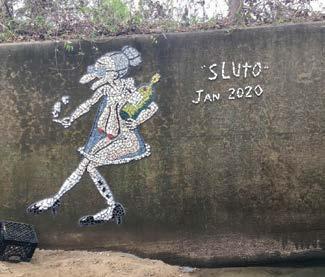
The mosaics were just like another way to push the envelope. I’ve lived in the Midwest for like 10 years. All there is in the Midwest
are freight trains coming through, and that’s the way you see graffiti. Most of it is pretty boring: you’ll look at a lot of trains and find nothing that interesting. So, for me, they’re all like a free canvas that you don’t have to sell and which is already primed. And you can paint whatever the fuck you want on them.
With trains, you have four hours to do whatever you want, and then it goes away and you don’t have to sell it to anyone else—it’s got this kind of novelty to it. So
I originally did the mosaics on freight trains, because I was just like, “oh, I have this free metal surface that I can just put a thing on.” Then I started doing them on the street as an extension of that, and eventually I figured out how to do them faster.
I think a lot of people don’t understand that graffiti is a communication thing. Like I go everywhere in the country, I see the same people that I kind of know in every city on the circuit of whatever weird shit we’re involved in. Graffiti’s like a tap for that.
So graffiti is a social thing—a means of communication?

Yes, and no. You don’t really communicate much with it— it’s more like a way of seeing who was here. That’s the limitation of graffiti and why it’s actually so boring. The notion of communication is a lie that I told myself of why I do art in the first place. I’ve been writing books and painting things for about 20 years now. Even when I was 24 and working in a cubicle in Minneapolis, I was writing books. I would write a novel
and then self-publish it and hope that someone would get it. That’s the goal: that someone understands you a little tiny bit. But then I had some thoughts about it last year. I was like, “maybe you just need attention.” That’s the flip side of pretending you want to communicate–you’re actually just desperate for attention. You know? I can’t tell which one it is.
Yeah, you say something like that in your Angel and Z interview. But it doesn’t seem to me like you do only graffiti because you crave attention. It’s just that some art needs to be social to work.
It could be an ego thing, because attention is all symbolic. If I got a bunch of money for my book, that would be one type of gratification. If a bunch of people liked my stuff and said “this is amazing,” that would be another type of gratification. Once you experience those types of gratification a couple times, you realize that they’re
pretty meaningless and empty.
I haven’t done anything good yet, you know, and I also don’t have a lot of “self-preservation instincts.” I have a lot of really bad habits. Sometimes I get concerned about that, and my immediate reaction is to think, you know, “I’m here for a good time, not a long time.” But I also know I’m not ready to die, because I need to do something good first. Even though I know it’s not going to make me happy to do something “good,” at this point, that happiness comes from the process and getting lost in it, and just like not wanting to kill myself for a day.... I sound so negative. I’m not always like that, but once I start thinking about these things, I get really negative.
It’s the existentialism creeping in.
Well, no one ever solved existentialism. That’s the problem.
A lot of times, I get the feeling that I’m on TV or
something. That’s how museums make me feel sometimes: I’ll go into a museum, especially in the contemporary section, and there’s some exhibition that’s just so insanely bad, stupid, really, based on, like, these bricks that were made from adobe by this guy who’s a fake Mexican using that to get into a museum. Whatever, good for that guy: get the fucking bag. But I know that people are coming in just to look at the fake adobe house. No real person gives a shit about that. But this guy got into a museum by writing about it or whatever. I get the same feeling when I go to some galleries in Chinatown: I feel like it’s a big joke and someone’s going to come out and say “people think this is really art, and people are buying this garbage!”
But the other end of that spectrum is making shit like I do, which is like vulgar, populist kitsch. Like I made this Super Soaker, this Hellraiser mask, this Nokia brick phone sculpture… Anytime I make a pop culture item, people are
desperate to buy it. It’s just like nostalgia art—I guess that passes for art these days. But what is supposed to pass for art? A landscape painting? Or an abstract painting that’s just like a gray square with a yellow line in it?
I don’t want to criticize our [American] art system too much. Have you read the John McPhee book The Ransom of Russian Art? It’s by this guy (who was probably a CIA agent, but he never admitted to it) in the 60s and 70s who was basically a bumbling idiot: he didn’t speak any Russian, but spent two decades roaming around Russia. In the Soviet Union you couldn’t make art, you basically could only make community murals which all had to pass through rigid censorship. So, this guy basically supported the entire Russian underground by buying all their paintings and bringing them back to the US. That’s why Rutgers has such a good Russian art collection—it’s all his collection. So I see how the capitalist
system promotes shitty art in its own way. But wouldn’t it be worse if you couldn’t make anything at all because there was no one to buy it? And if there was no money and all art had to be community-mural-level stupid? Even though I think that children’s murals are the highest form of art.

Part of the thing with museums is that they’re so
undemocratic. That’s what makes music special, you know: everyone likes music, so with music, the proof is in the pudding. If you’re a DJ, and you play music and people dance, you’re doing a good job. With [visual] art, in the gallery system, there’s no judge other than the people who are already well-established within the institutions. There’s no public bar that visual art is held to, where the public can say “we all hate this shit” and prevent people from getting paid for bad art. The
“art market” isn’t beholden to most people.
Well, maybe it’s not that everyone likes music and fewer people like visual art, it’s just that everyone can buy music and participate in the music market, but almost no one can buy the art being sold on the art market. Is there political art, is there
such a thing?
Hmmm, there’s definitely art that tries to be political, but I think almost all of that art is bad. But I also think all art is social. Either it’s responding to the information you take in from the world around you, or it’s a way of interacting with the world, or it just captures the way you see the world. So it’s always
sort of political.
Yeah, even if it’s not, then it is in its own way..? I’m not sure that thinking about any of this matters at all, honestly. Most people don’t give a shit about any of this stuff. That’s the other part of art that’s such a bummer: getting really lost in this stuff.
This is the first year where I’m pretty much banking on the art shit to, like, pay my bills, which is a terrifying prospect. It’s been really nice to have had to work jobs this whole time, because I get to interact with real human beings. That’s the doubleedged sword of success: it isolates you. Even with the amount of work that I put in here now, I don’t get to go outside a lot. I’m just in my studio. I’ve met successful older artists, and they’re usually really desperate to hang out with young people that they see as vibrant or hip because they’re not a part of that world anymore. You know, they’re not a part of the world.
much of a problem with graffiti and mosaics: you have to actually interact with the outside world to make them. The thing is, it seems like turning it into a job would turn it into something else.

Yeah, you really do run into the double-edged sword with art and success. Philly’s a good example of that:
Philly’s full of murals that are kind of bad. I mean, they do have some really good ones, and they’re all much better than New York murals because Philly has its own entire mural style. But, even their murals are kind of bad, because they have to pass this bar to fit into a community, so it can’t really critique anything. It can only be like, “Get it!” “You can do it!” type art.
Which is similar to what you’ve said about murals in the Soviet Union.
It seems like that’s not as
Yeah. They made good art—I mean, they stole 80 years of people’s lives, but their murals are the reason I started doing mosaics in the first place. When I lived
in Ukraine, I lived on this island in Kiev. There, you would just walk down the street and see a 50-foot long wall with a mosaic on it, about eight feet in the air. Most people there kind of hate the mosaic because it’s a reminder of the Soviet Union–most people are really not happy that they were essentially imprisoned for 80 years. So, I think public art definitely can be good, but it’s such a thin line to walk between good and bad public art.
There’s a historical disdain among graffiti writers for street art. What’s the difference between graffiti, street art, and public art? Where does that dislike for street art in particular come from, and why does graffiti escape that criticism?
I mean, street art is like the most capitalist, shitty version of graffiti. Street art took the idea of graffiti, being this illegal, whatever, thing and just used it to make money. But also, I think graffiti people are jealous because street art happened, a bunch

of people making street art made money off it, and graffiti people got nothing.
Also, aesthetically, street art is horrible. I don’t know why it’s so horrible. It’s kind of the same as graffiti: I always think like, “God gave you infinite canvases, and you couldn’t find anything better do than write your fucking name.” With street art, I think “you have infinite walls to do whatever you want, and all you can think of is drawing a cat pizza.”
It’s also an intent thing. Street art isn’t done by people who want their art to be on the street. It’s always in very sanctioned areas. There are actually people that have been street-arty practitioners, but they do it in really random places. That’s cool because you can tell they’re not doing it with the intention of getting a gallery show out of it or something. But most street art people have the intention of doing like five murals and then having a gallery show. Most people get into graffiti because they hate their dads or have some, like, mental
disorder, you know.
As for public art: I think graffiti people respect public art in that they don’t want to deface it as much. Murals don’t get defaced unless they’re of the Bushwick variety. Those have kind of lost all respect. But things like elementary school murals get more respect.
I sometimes get lumped into street art. But because in contemporary times, graffiti is just writing your
name on something over and over again, even what I do with the mosaics (I have my name on them) is technically graffiti: I’m getting my name up in a place for people to see it. But my mosaics don’t fit these rigid guidelines, so really traditional graffiti people have a problem with it.
Also, I started trying to do these 3-D mosaics on the street, and people steal them. They’ve been scraping them off the walls and like powerangle grinding them off and shit. I had old ones that were easier to steal, but the
new ones are really on there. Someone tried to angle grind one of them off, and couldn’t get it off, so it’s like half destroyed.
Can you think of any public art that you like?

Like state-sanctioned?
Yeah, or a public sculpture or something? You can’t steal this, okay, but if I had a billion dollars and I couldn’t just give it to a good cause, I would love to make a Richard Serra-like 50-foot wide metal cube and just helicopter it out behind a strip mall in the middle of
the night without ever telling anyone. It would just be back there where teenagers could smoke weed: just a meaningless cube in the middle of nowhere.
Like a giant generator.
Just like something weird that has no reason to exist. I wouldn’t want credit for it either: I just want people to interact with this stuff, like this guy [Joselit] is saying. I think that’s really cool. I guess architecture is kind of like that, but I’m too much of a philistine to really understand architecture.
Dr. Lwazi Lushaba is a political studies professor at the University of Cape Town. He has written several publications on contemporary African political theory, focusing on neo-colonialism, modernism, and Pan Africanism, including “From National Liberation to Democratic Renaissance in Southern Africa.” He is joined by his former student, Ziyana Lategan, a current Ph.D. candidate in the Department of Comparative Literature at Binghamton University and a Fulbright scholar from Cape Town, South Africa. They explore Dr. Lushaba’s core topics in this interview, expanding upon his view of what the next course is for African people from a philosophical lens.
Gadfly: Can you please give me your name, what you’re currently doing for work, and the most important aspect of either the work you’re currently doing?
little philosophy—more particularly what I call African modes of cognizing. Of course, I invariably have to study modernity, which denies those Africans modes of cognizing.
Chimelu
Lwazi Lushaba: Thank you very much, Chimelu. My name is Lwazi Lushaba. I am currently a member of the faculty at the University of Cape Town, where I teach in the discipline of political science. But my interests are much broader than just political science. They lie more in the history of South Africans, social sciences generally, and a
Ziyana Lategan: Thank you so much, Prof. My name is Ziyana Lategan. I am a Ph.D. candidate at Binghamton University in upstate New York. I was a student of Professor Lushaba’s at the University of Cape Town some years ago. Right now, I’m working on my dissertation which aims to formulate a concept of dialectics across the colonial
Ani, ed. Oscar Luckett
divide.
You stated how Europe as a singular homogenous entity only began to exist as a way to distinguish itself racially and culturally and ethnically, from the Other, that being non-European groups. Do you think there’s a use to Africans engaging in the same tactic, perhaps under the guise of Pan Africanism, to push back against the remnants of colonial power?
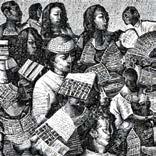
Lwazi Lushaba: The idea of being European, that we know, is entirely dependent on the “other.” Remember, Europe itself was internally segregated; there was never this homogeneous idea of being European. The only thing that brought Europeans together was their distinction from the “other.” Now, we know from the theory of identities of social identities, that all identities are relative. The reason you have a name like Chimelu is to distinguish you from Lwazi Lushaba; if you were the only person on earth, you wouldn’t need a name— you would be the human
on earth. Not only were there different cultural and ethnic identities, there were actually very antagonistic relations between these different groups in Europe. There were groups that had enslaved the other. So there is no homogeneous Europe that just emerges onto the surface. That internal coherence is made possible by the “other,” which is Africans and the non-western world generally. The reality of what Europe possesses is not in itself, but in what the other does not have:
“We have capability for thought.”
“Prove it.”
“See those ones that don’t have it. We have a sense of the aesthetic and the sublime. We have it as Europeans because those other ones don’t have it.”
Of course, the process is not a co-creation, because the “other” is not a participant in it. The other is spoken for. The attributes of the other are actually given to it by Europeans. So, our attributes are not our own. That’s why we are always denied and why we exist in a zone of
negation, as Fanon would say, because we’re described by being non-European, non-western people. So, we’re defined by lack. We are a people defined by lack in every sense of the word, because when you say we are none, it means we are defined by what we are not. And what do we lack? Of course, we lack intelligence, we lack culture, we lack a notion of the aesthetic and whatnot.
Now, the point you are making is, “Then can we reverse that logic so that we may get out of it? Get out of this relationship as Africans?” We, as Africans, unfortunately, do not have the luxury of naming ourselves. Even the idea of being African is given to us.
Now, there is an interesting debate that goes on in Africa in the 1960s between Ali Mazrui and Nyerere of Tanzania. Nyerere speaks of an African and says that we have to hold onto the idea of being African because there are Africans. Ali Mazrui responds and says, “No, you’re not correct. The very idea of being African is a product of colonialism, it is colonialism that told you, Africa, there was no Africa prior to colonialism.” Indeed, Mazrui is correct. The idea of the continent called Africa only comes into existence via colonialism. We don’t have the luxury of naming ourselves. But Nyere was not done responding to Mazrui. Nyerere says, “You see, when Mazrui asked, ‘Who is an African?’ the answer is simple, it is that the African looks the other in the eye, anywhere in the world, and knows that in relation to the European, they are one.” He was saying that part of our legacy as Africans is that we are not definable outside of our contestation with the West. It’s a critical element of being African. So, part of being African is a political
identity. Now I suspect that there, Nyere was attempting to essentialize what it means to be African, such that you find these essential elements innately in me, in Chimelu, in whoever else is an African. What Nyerere was saying is, “Being an African is partly a constructed identity that has in it integral, a political struggle.” We are in an oppositional political struggle with Europe, so I don’t think it is a matter of choice. If we don’t have a category under which we are struggling against Western modernity, then we would not be able to mobilize resources. Undoubtedly, we do need Pan-Africanism as a category, so that we may know that an African looks the other in the eye and knows that—in relation to the European—they are one.
Ziyana Lategan: Disunity as a weapon for domination is so powerful. I think about the borders that Europe has implemented on this continent. They are obviously such ridiculous fabrications used precisely so that colonial powers could chop up the continent
and decide what they were going to take for themselves. The West often preys on the fact that it can co-opt these junior partners. And in that way, it can: it can relinquish and absolve itself of responsibility by labeling the violence they caused as ethnic or tribal violence. They can leave and say, “Oh, look at those people fighting. They can’t get along,” when this is instigated by a colonial or imperialist power for its own gain. I think PanAfricanism is possibly, in my own opinion, still the only way to combat this relation of domination. So yes, PanAfricanism. Absolutely.
Lwazi Lushaba: If you have had the fortune of watching a few of those Pan-African cultural festivals, Festac, you
would know what it does to you as an African. The feeling you get watching Fela Kuti play alongside Miriam Makeba: it’s not material, it’s not tangible, but you emerge out of it with a certain sense of confidence—that the world was actually never, from the beginning, made to hate black people. And that sense is the edge from which can spring determined political action. And so I don’t think that Pan-Africanism is just a political project. There are cultural resources that we are gradually losing because we are no longer nourishing that Pan-African spirit. I urge you to find an interview between Lewis Nkosi, Chinua Achebe, and Wole Soyinka, as young people in 1977, sitting somewhere in Lagos talking about the African aesthetic. We lost that moment. But watch that interview, and you perhaps would be able to tell me what I’m not able to express about what it does to the Spirit.
What factors have led us to be skewed from that path of Pan-Africanism that we

were on in the 1960s or 1970s?
Lwazi Lushaba: It’s a combination of things. The impetus for Pan-Africanism was in the late 1800s, but there is a whole discourse that ferments from the 1900s when the first Pan-African conference was held. There is a growing language about what it means to have a Pan-African ideal. And I don’t think the West took kindly to a growing body of thought that was not geared towards the European. These were Africans talking to themselves, seeking no validation or brownie points from Western institutions and Western audiences. Many of the people who study art today would tell you of the foundational role that Festac played in the imagination of the African person after the attainment of independence. At the time, Nigeria and a few other African countries had the financial muscle to organize those kinds of conferences and festivals. Once the oil crisis and structural adjustments hit in Africa, there was
virtually no economy in Sub-Saharan Africa. A PanAfrican project would easily have been dubbed a vanity project by the West. There was obviously deliberate sabotage. But, it is also likely that the economic conditions in the continent made these seem like a superfluous expenditure. We failed to say that this is perhaps where the foundations of an alternative—a real alternative—to the West are going to be laid.
Ziyana Lategan: When we think about Black Studies in the U.S. now, in the academic sense, there was definitely a moment where it had a very strong Pan-African outlook. But even now, globally, resistance politics no longer asks big questions, such as the problems of imperialism. It has become fashionable in the U.S. now to talk about prison abolition and maybe forms of mutual aid. The concerns have become so localized that even African Americans don’t really conceptualize a struggle that’s linked to African liberation in the way that marked the resistant politics
of the 60s and 70s. And what ends up happening is that it becomes a kind of toothless endeavor, and so becomes the fashion of PanAfricanism.
Both Western and African philosophy departments often subject African and indigenous philosophies to the scrutiny, analysis, and interpretation of Western philosophy. Is decolonizing in this vein necessary to establish a truly African concept of development?

Ziyana Lategan: I think decolonizing is a necessary aim. I have problems with the concept of development altogether. Obviously, cultures and ways of thinking change as they develop on their own; it so happens that the modern world is a product of change caused by colonial domination and eurocentrism. And so, I think all areas of thought would need to be decolonized—not just philosophy departments: the social sciences, the humanities, but also the sciences. I think, a lot of the time, our modes of thinking
are based on a reality that is invented by the West. We’re grappling with problems that are not even ours, or problems that we could solve in a variety of ways that are not given to us by the West. First, departments have to decolonize. I need to read people from all over the continent. But our disciplinary, methodological, and political and ethical commitments also require a decolonizing effort. And so to say, “the philosophy department needs to teach more African philosophy” is to precisely miss the point that talking about “philosophy” already funnels our thinking into disciplinary and methodological boundaries that are just terrible inheritances from the history of Western thought. These are deterrents to creating self-determined modes of being together, of organizing societies, and of responding to very pressing concerns that we have. In that sense, we’re getting ourselves in the parasitic relationship that the West has with us in the material sense, while treating ourselves with these very
deep rooted psychological and epistemological problems that we’ve taken on from the West as well.
Lwazi Lushaba: Professor Lategan has already alluded to the first problem, which is to retrospectively apply Western categories of knowledge to African modes of cognizing. If they ask us “What is your philosophy?” and we scramble and say, “No, here we have philosophy. Here, here is our own philosophy, African philosophy.” Next they ask us, “Where’s your botany?” and we scramble again. And at some point, we’re going to run out of the resources, because those are not our categories. You would know that’s not how we categorize knowledge if you have a
slight idea of the bodies of knowledge that existed in the continent prior to colonial conquest. I can think of an example immediately: the Kano Chronicles from Nigeria. Now, regarding the few that have been translated into English, when you read them, it will strike you that you can never tell the boundary between what we would today call the religious and the social. You would never know the boundary between the political and the economic, or you would never know the boundary between the cultural and the scientific. For example, the use of plants for
medicinal purposes was not medicine, it was part of culture. As Ziyana says, those disciplines, as the West has imagined them, have their own methodological underpinnings. We are told “Oh, this is your philosophy,” but philosophy functions on the basis of argumentation. We don’t see that methodology reflected in what you call philosophy. The other problem at the foundation of Western knowledge is the philosophical idea of man. The whole enterprise of Western knowledge relies on the philosophical idea of man having to be the proprietor of knowledge; the
man possesses reason that is unencumbered and produces knowledge. And so, that’s why knowledge everywhere must have a proprietor. So, the discovery of man by Europe had implications for every discipline. The idea of knowledge as existing

only in disciplines is itself very limiting. Disciplines have their own assumptions. The problem is that to equate ourselves to Western disciplinary boundaries means we are already defeated.

Beyond Geschichte and Itihāsa: Theorizing History from the Margins in Colonial India
Mrinalini Sisodia Wadhwa, Creative Commons
Buccolia Julia Lange
Concrete Horizons: Against Utopian Myopia with Bernard Harcourt
AI-Generated Artwork, Creative Commons, Sherrye Ye
Writing for One: Reframing the Author-Reader Relationship Sherrye Ye
Thoughts on Latin American Thinking Sherrye Ye
Art for Corpses, Art for the People: Interview with SLUTO SLUTO
The Panacea of Pan-Africanism: Discussing Decolonization with Lwazi Lushaba and Ziyana Lategan
AI-Generated Artwork, Creative Commons